Street Fighter: The Storytelling Game by Halloween Jack
Rebirth of Honor
Original SA post
Did you know that at one time, in 1994, White Wolf actually made a licensed RPG? Would you believe that the game was primarily about combat? Stranger still, would you believe that it was actually well-designed?
If you can swallow that, you might just be ready to play
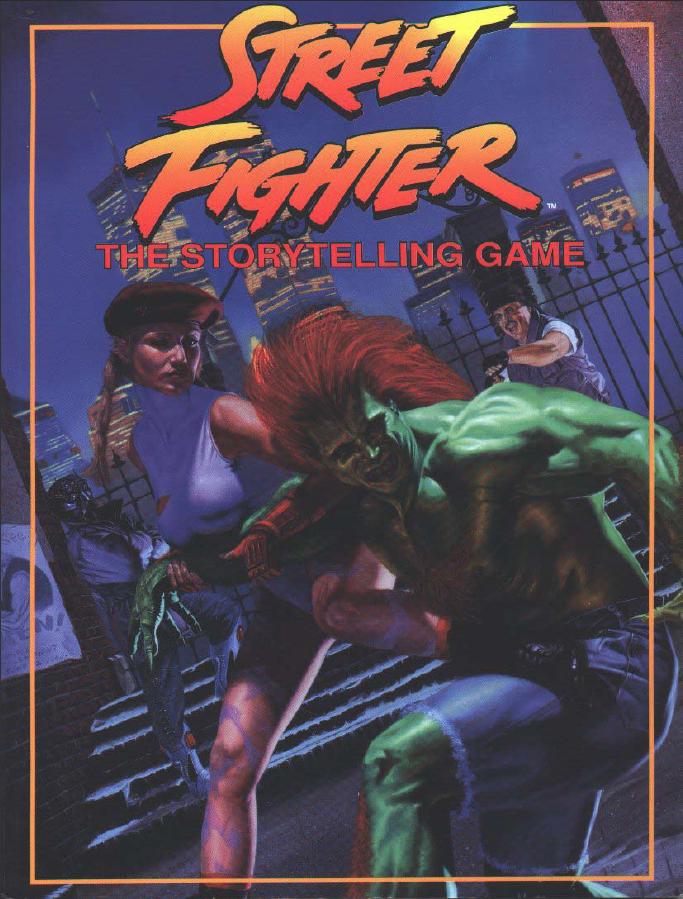
“If you’ll just cradle my boobs, I can totally vault off your balls and KO the Brooklyn Brawler over there.”
Prelude: Rebirth of Honor
Look, just because this is a game about vidja game kung fu fightin’ doesn’t mean you’re ever going to get a White Wolf game that doesn’t open with tedious fiction. “Rebirth of Honor” is a short story about Maurice Jackson, a kung fu master returning to visit the wizened old Chinese master who took rescued him from poverty and taught him how to punch people to death.
Maurice is a good fighter, but out of practice, and while sparring Master Kwan’s new student, Pao, he loses control and hits the boy with a Dim Mak strike that would kill him if Master Kwan wasn’t there to heal the boy with his mysterious chi powers. Master Kwan chides Maurice for his laziness—Jackson has turned kung fu into a business, opening a dozen schools and wearing a curiously karate-style uniform with cobras and lightning bolts and a lot of gold jewelry, and let his kung fu technique and his marriage slip through his fingers like so much bling-bling. Jackson storms out.
An effeminate Spaniard named, I swear to God, “Felipe D’Aragon” shows up at Master Kwan’s front door. Felipe is a Spanish Ninja. Y’know, like Vega. Except he wants to be the man by beating the man, and he thinks mastering Kwan’s Dim Mak technique is the answer. Kwan refuses. Fade to black.
Jackson, having realized the error of his ways and resolved to be a better father/kung fu master/dresser, returns to apologize, only to find that D’Aragon has murdered Kwan and Pao. Jackson drops into Tiger Stance and beats the holy hell out of D’Aragon’s minions, who are, of course, a lot of faceless big guys in black suits and sunglasses. Then he squares off with D’Aragon.
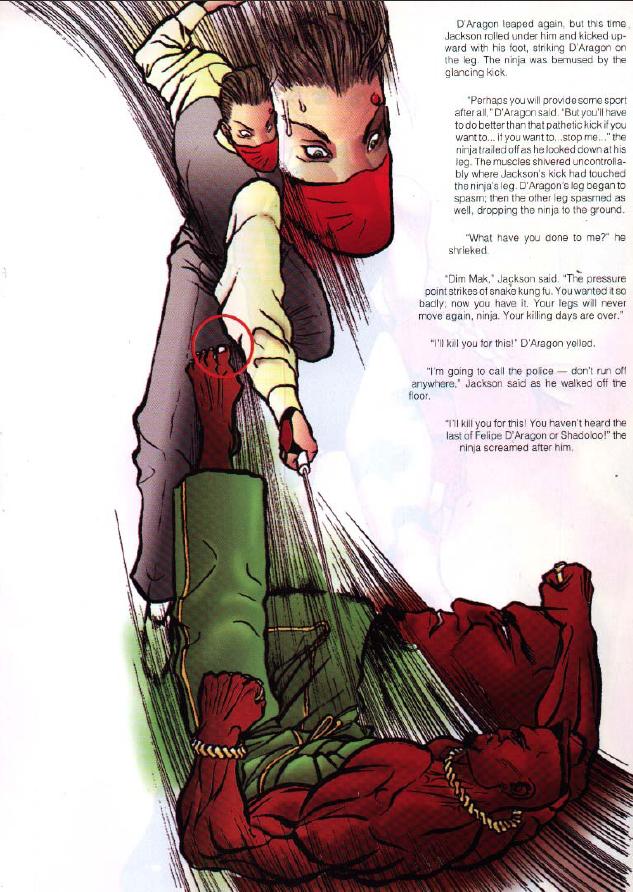
Wesley Snipes is: Death Toes
D’Aragon is good. He leaps at Jackson again and again, and each time Jackson dodges almost in time, receiving a cut from D’Aragon’s swordcane. Finally, he counterattacks by flopping backward and hitting D’Aragon with a glancing kick to the leg. The assassin laughs it off until he realizes he can’t feel his legs anymore—Jackson has just rendered him paraplegic. Jackson goes to call the police while the bad guy screams that he hasn’t heard the last of Shadoloo!
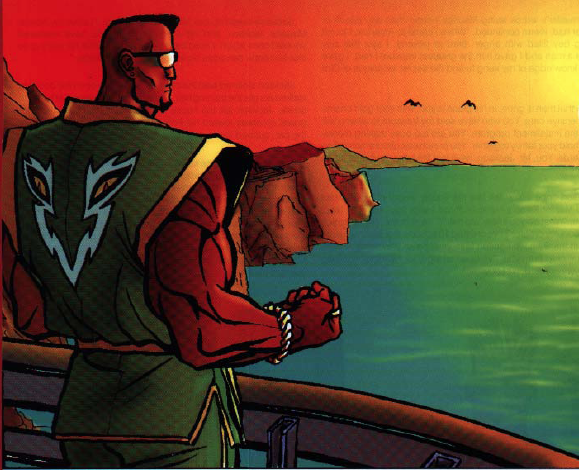
“Go,” said Jackson. “Go, go, Power Rangers.” The Power Rangers went.
Introduction
Original SA post Street Fighter, Chapter 1: Introduction”Fool! I but clench my hand and the world trembles! My agents are everywhere, longong to do my bidding, fighting each other ofr the right to serve me. You think you can stand before my Shadoloo army? Fah! And even if you somehow defeat my servants, you will still have to face me. No one has ever defeated me—and no one shall.
--M. Bison, Lord of Shadoloo and mad overlord who says “Fah,” describing his plan to conquer the world with crime.
Words cannot protect you against the inevitable hand of justice! Fight whom you will, corrupt whom you may; you will not stand before me when I put an end to your tyranny.
--Ryu, Grand Master Street Fighter and boring do-gooder prick, being a boring do-gooder prick.
White Wolf undoubtedly hoped to draw in new players who aren’t part of the regular RPG crowd, as the Introduction chapter starts with a “What is roleplaying?” section that goes on for like 2 pages and reminds you not to actually hit people. Thankfully, it does include an example of play, wherein Pantara, Dali, and Mindbender beat up some thug minions of “Lord Smythe, the big-time crime boss.”
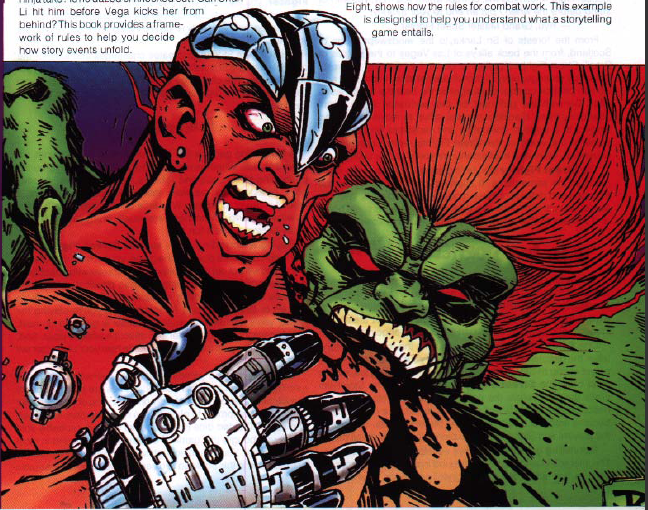
As SA may have shown you, the art in this book has a weird fixation on mutants fighting cyborgs.
Street Fighter, Chapter 2: Setting, the World of Street Fighter
A fighting video game, in and of itself, doesn’t have much of a setting, and the Street Fighter RPG doesn’t make a serious attempt at worldbuilding. Nor does it rely on any officially licensed comic books to provide the setting—at the time of release, Marvel had just made a failed attempt at a SF series, and the manga were just coming out in Japan. So the default setting of Street Fighter is a warped version of the modern day, “a world where crime cartels rule the streets and spies stalk the corridors of power.”
The implication is pretty clear that the setting is supposed to be “Hollywood-produced martial arts movie.” Organized crime is everywhere and has an implausible amount of power, and governments are mainly present in the form of James Bond-style espionage agents. It’s up to the PCs to solve social problems and geopolitical conflict—by kicking it in the face.
Street Fighters
Street Fighters are pretty much exactly that—those who take part in a tradition of (mostly) one-on-one fist fighting in streets, alleys, basements, parking garages, and isolated arenas all over the world, for honor and glory. There’s no mention at all of an organization that runs it all, or a history of the traditions involved. Lots of Street Fighters are selfish thugs. Lots of Street Fighters want vengeance on M. Bison because they were victimized by his criminal empire—apparently he leaves “plucky youth sworn to vengeance” types in his wake all over the globe. M. Bison’s reign of terror will continue until some talented young fighter finally defeats him, says the book, we can’t just elect a Republican who will accuse him of selling Scissor Kick missiles to terrorists and use it as a pretext to invade the country he lives in and rules openly.
The World Warriors
Yes, the ones from the games! A handful of Street Fighters are clearly recognized as the top dogs. Every Street Fighter dreams of becoming a World Warrior. It isn’t explained how this happens.
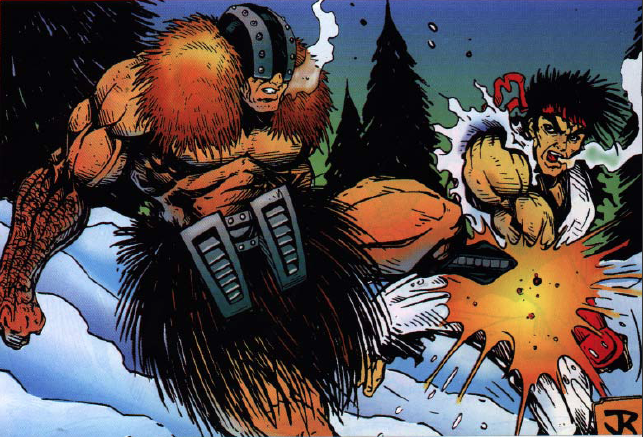
After this fight, Ryu was declard Kahuna of Bartertown.
Balrog: A heavyweight champion who turned to street fighting after he lost his title in a “controversial knockout.” (That’s funny, as a knockout is the least controversial way to win in boxing.) Balrog was a poor kid who became the American Dream; unfortunately, he’s willing to do Bison’s dirty work to maintain his fame and fortune.
Blanka: A green mutant from the jungle. It’s said that he taught himself Capoeira (how does that even make sense?) and learned his electric powers from electric eels (which is actually more plausible). Whatever his history, he’s not talking.
Cammy: Only two things are known: She’s a British secret agent (which must be hard when you’re an internationally famous athlete) and a great Street Fighter. Other than that,

Chun Li: A wushu master and an Interpol detective. (This is the 70s crime film version of Interpol, that actually conducts investigations and arrests people.) Wants revenge on M. Bison for killing her father.
Dee Jay: A reggae musician/kickboxer. And he has that shit-eating grin. That’s pretty much his story!
Dhalsim: A yoga master who is on the verge of perfecting his existence and transitioning to a higher state of consciousness—the last step in his enlightenment is beating the tar out of people with Kabaddi, his secret yoga martial art.
Fei Long: A kung fu action star who gave up on his film career in order to perfect his kung fu fighter skills. So he’s Bruce Lee traveling backward in time.
E. Honda: Despite being a massive scary bastard, E. Honda’s fundamental drive is to prove that sumo is a valid fighting art, which he does year after year by slapping people around and sitting on them.
Guile: A former fighter pilot who developed his Sonic Boom technique after an experimental supersonic aircraft flight went awry. Bison killed his best bud, so his ultimate goal is to tear M. Bison limb from limb with his Special Forces fighting skills.
Ken: Trained alongside Ryu in Shotokan Karate by the great master Gouken, Ken is one of the most famous and adored Street Fighters, not that he lets it make him soft.
Ryu: The current Grand Master Street Fighter, after taking the title away from Sagat. He lives for nothing but perfecting his fighting skills, and has since retreated into solitary training. Did I mention this guy is just really dull?
Sagat: A Muay Thai kickboxing master and the former Grand Master of Street Fighters, Sagat is obsessed with winning his title back from Ryu. He’s allied himself with Bison in the hope of luring Ryu back into competition.
T. Hawk: A Native American who supposedly learned his wrestling style directly from the great hawk spirit. He’s also in the tournaments for revenge against Bison, who scammed his tribe out of their ancestral lands.
Vega: An insane narcissist who combined ninjitsu, savate, and techniques learned from his career as a bullfighter into an acrobatic hybrid style he calls Spanish Ninjitsu. A freelance assassin, he sometimes works for Bison.
Zangief: Zangief is a Russian patriot who fights to prove the strength of his people. He trained by wrestling bears, and is a folk hero to the Russian working class.
M. Bison: Formerly a military dictator in Thailand who decided to leave and found his own worldwide crime cartel. He rules his own country (name and location unrevealed) for the diplomatic immunity, and uses his psychic powers to expand his criminal empire. He wants to destroy or control talented Street Fighters, as individuals with great strength of will are difficult to control.
(As an aside, you may know that originally, M. Bison was Vega, Vega was Balrog, and Balrog was M. Bison. When translating the games to the US, Capcom had to cover up the fact that “M. Bison” was just a joke name for Mike Tyson—and they decided shuffling the names around was a better idea than one new name. M. Bison’s “M” doesn’t stand for major, as far as anyone knows. It may as well stand for “Mike.”)
Fighting Styles
Characters in Street Fighter don’t have rigidly defined classes, nor lineages like you see in some other White Wolf games. They’re separated into fighting styles, which leave you some flexibility in what moves you learn. The thing about the fighting styles in Street Fighter, though, is that they’re completely made up or don’t have much in common with their real-life counterparts. That’s after you allow for moves which have people flying through the air and stuff.
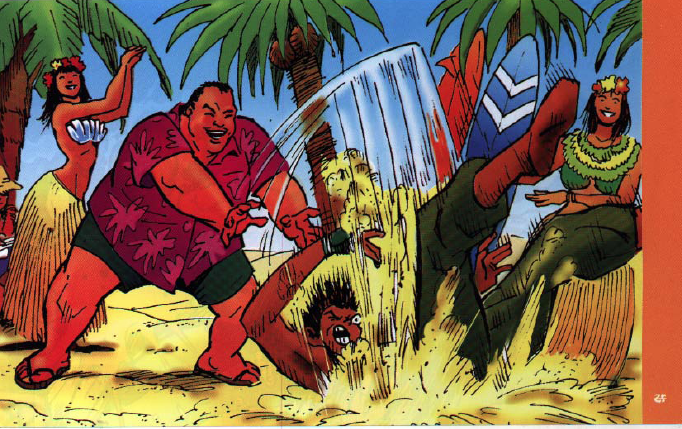
A masterful Brodokan throw.
Boxing (Balrog): Yeah, it’s pretty much boxing cranked up to 11.
Capoeira (Blanka): Like “a mad festive dance with many leaps and spins,” of course, Capoeira stylists learn Blank’s spinning and rolling attacks rather than, say, handstand kicks; this is a lot less true to the real thing than Eddy Gordo’s capoeira in Tekken.
Kabaddi (Dhalsim): A yoga-derived martial art that involves physical manipulation of the body and clever dodging.
Kung Fu (Fei Long): There are many styles of kung fu, the game acknowledges, and it has a diverse set of moves you can learn.
Ler Drit (M. Bison): In real life, Lerdrit is a simplified form of Muay Thai they teach the Thai military. In Street Fighter, it’s M. Bison’s personal brutal kickboxing style combined with dark psychic powers.
Muay Thai (Sagat): Yep. Muay Thai.
Native America Wrestling (T. Hawk): A wrestling style developed by unspecified Amerindian tribes to train braves, it relies on strength and attunement with nature.
Shotokan Karate (Ryu, Ken): In real life, it’s a very popular style of karate that relies on linear sliding footwork, straight punches, forceful blocking techniques, and simple punching and kicking combinations. In Street Fighter, it’s Gouken’s form of extra-good karate that he taught Ryu and Ken, and it involves flying attacks and fireballs.
Spanish Ninjitsu (Vega): An acrobatic ninjitsu/savate style that relies on climbing and leaping for power.
Special Forces (Guile, Cammy): A brutal hybrid of boxing, karate, and jiu-jitsu designed to win as quickly as possible.
Sumo (E. Honda): Honda’s combat sumo relies on sheer size along with grappling and slapping.
Western Kickboxing (Dee Jay): Resembles Muay Thai, but makes more allowances for punches and fancier kicks. There’s actually some real-world basis for this—karate and tae kwon do guys in America started fighting full-contact in the 60s and 70s, adding boxing to their repertoire, and didn’t really come around and recognize the influence of Muay Thai until later. Then they started influencing each other and Thai fighters started adopting more fluid handwork from boxing…but I digress.
Wu Shu (Chun Li): A more acrobatic, showy style of kung fu which is huge in China. (In real life, wu shu is the name of officially sanctioned kung fu in China, which has sparring and form competitions. Think Jet Li and Donnie Yen.)
An important concept in Street Fighter is Chi , life energy which exists in everyone but which only a few can harness. Chi is power that fuels martial arts maneuvers like Ryu’s Hadouken and Guile’s Flash Kick. The mastery of Chi is supposed to lead to a higher level of consciousness, but that has a dark side—M. Bison is obviously attuned to his own Chi, and he’s still a megalomaniacal bastard. In game terms, there’s no difference between good Chi and evil Chi.
Sensei
You can’t become a master of Shotokan Karate, or Kung Fu, or Boxing by just going to a gym and training really hard. You need a close personal instructor, a Sensei. (Apparently the Japanese word is used often among Street Fighters regardless of the art.) A Sensei teaches the Street Fighter the higher secrets of the style, and is expected to be a mentor who provides moral guidance. Good Sensei understand that they’re training individuals to be the representatives of their fighting style to the world. Gouken, Ryu and Ken’s teacher, is the most famous living Sensei, and other teachers from other arts consider him a guiding light.
Honor and Glory
Street Fighting carries a common code of Honor. Essentially, the whole tradition of Street Fighting breaks down quickly if people start rigging or disrupting fights—that’s a quick way to get beaten or boycotted out of the scene. Upstanding fighters don’t have to worry too much about agreeing to fight shadier ones, thanks to the code of Honor.
You can be an honorable fighter without being a nice guy, though. Vega is honorable in the ring; outside of it, he’s a murderer. Balrog is only as honorable as he needs to be to maintain his image. Bison is so powerful and influential that he can easily commit grievous violations of Honor with impunity—the book follows with a story about Bison agreeing to fight a savate master, but distracting the fighter by having his wife kidnapped and displayed in the stands. Not that Bison needs to do these things to win; he’s just a bastard.
Glory isn’t an officially recognized term in the setting like Honor, but it’s also a game stat, and it’s important. Glory is a Street Fighter’s ticket to fame, money, more prestigious fights, better training, and eventual induction into the ranks of the World Warriors.
Honor and Glory are game stats; later in the book, it explains how to gain and lose it, and what it gets you.
Teams
Oh shit, this is where the “This is a roleplaying game and roleplaying games are designed for group play” concept has to be hammered into the setting. Most Street Fighters work as part of a Team. It makes a lot of sense, actually—like the members of a rock band, a team of fighters can share management, facilities, and transportation. There are also team fights in Street Fighting, and team members can sub for one another in tournaments if somebody gets injured. Then there’s the fact that an up-and-coming Street Fighter will inevitably run afoul of criminals, and team members can watch your back. Team members usually have a common goal besides networking together, though. If you guessed that the most common is “revenge on Shadoloo,” you’re a winner!
There’s a section on managers. Again, like a rock band, a team can really use a manager NPC to help their career. This may seem like a trivial logistics element best dispensed with, but a manager can get a team better fights, more money, into a grand tournament in an exotic locale, or know enough about your opponents to give you good tips. Of course, at some point you’ll have to rescue them from a burning factory with only seconds to spare.
Tournaments, Adventures, Arenas, and Geography
Tournaments are how Street Fighters get decent fights; plot-wise, they’re an excuse to send the PCs to exotic locales to solve mysteries with their stupid pot-smoking dog. Tournaments are associated with a particular Arena. Taking a page from the game, the fighting Arena might be the dock of a fishing village, an airport tarmac, a familiar boxing ring, or a crumbling coliseum on a remote island. Now, for the round-the-world tour.
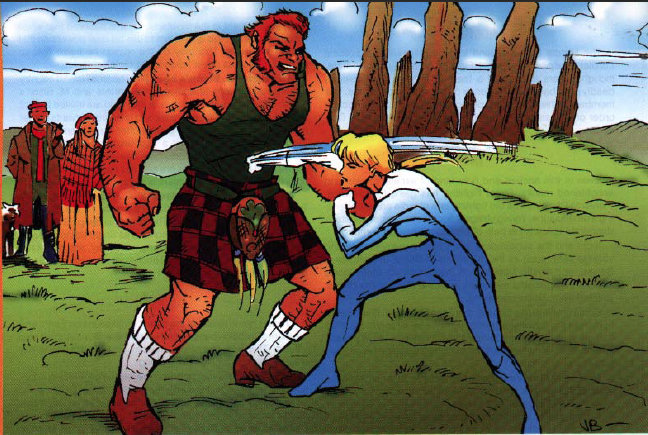
I hear golf is very different in Scotland.
North America : Street Fighting is illegal but popular in the US, and thus an underground sport. Tournaments are held in secret locations that usually aren’t glamorous—yeah, think of every “fights to the death for the amusement of the decadent rich” martial arts movie made in American in the 80s. America is rife with violence and street crime, and organized crime has wormed its way into the Street Fighting scene. Much of this is Shadoloo, and the rest is the American Mafia families. Notable arenas in North America are Guile’s airfield, Ken’s dock, and Balrog’s casino arena.
Central America, Caribbean : Central America is plagued with crime and high-level corruption, which international organizations are unable to penetrate diplomatically. Noble Street Fighters stand a good chance of becoming folk heroes here, with fighters like Dee Jay and Mexican luchadores enjoying a lot of popularity. Notable arenas include T. Hawk’s village square and Dee Jay’s tourist trap joint.
South America : Street Fighter really plays up the idea of unexplored jungles, lost cities, and strange mutants lurking outside the urban areas. Street Fighters will also have the chance to battle criminal cartels and deforesters. Although there are a lot of capoeiristas in Brazil, Blanka’s fishing village is the only notable arena.
Europe : Street Fighting isn’t too popular in Europe, where it’s considered rugged and ungentlemanly. Apparently, all Europeans in Street Fighter are Braithwaite from Enter the Dragon . Street Fighter has caught on with the youth culture, though, and Shadoloo has started committing terrorist acts in major cities. Notable European arenas include Vega’s cage ring and Cammy’s castle.
Russia : Street Fighting is actually a popular culturally unifying sport in a region torn by dissolution and kleptocracy, which Shadoloo is capitalizing on big-time. Zangief’s factory is the sole notable arena.
Africa : No World Warriors have emerged from Africa yet, but it bears watching, as up-and-coming fighters are emerging with new techniques based on rediscovered fighting styles. Like South America, Africa is another place to look for lost martial secrets in the wilderness. Some believe that an “intelligent ape” similar to Blank lives in Africa. Hoo boy. Of course, Shadoloo is capitalizing on the constant factional strife.
Middle East : Nobody here but us chickens. There are rumours about Street Fighters with ancient assassin techniques, but nothing solid.
India : Dhalsim has inspired a lot of people to try to kick ass with yoga. Remember, this was in 1994, before that became a popular delusion among housewives. More crap about strange mysterious ancient ruins, blah blah blah. The only World Warrior arena is Dhalsim’s elephant temple.
Southeast Asia : This region is Bison and Sagat’s domain. Bison rules the small island nation of Mriganka, from which he rules Shadoloo with an iron fist. Interpol keeps recruiting teams of Street Fighters to infiltrate the region without much success. The notable arenas are Bison’s palace and the remote Buddhist retreat where Sagat trains to retake his title.
China : There are, of course, a buttload of Street Fighters in China, and the government seems to be pretty friendly towards it, as it goes hand-in-hand with the Hong Kong film industry. Shadoloo, of course, has infiltrated the low-level government bureaucracy and makes money from manufacturing which violates human rights. Notable arenas include Chun Li’s village market and Fei Long’s exotic temple.
Japan : Street Fighting is booming in Japan. Everyone wants to be Honda or Ryu. Moshi moshi desu kawaii. Also there are of course Yakuza, and Shadoloo of course owns a big chunk of that action. Notable arenas are Honda’s bathhouse (good excuse for fighting in a fancy diaper) and Ryu’s totally boring rooftop dojo.
Australia : There is nothing work talking about here except more rumours of weird stuff in the Outback and of course people spread rumours about a kickboxing kangaroo.
There’s a brief note on Fans . Like any town with an arena, Street Fighting can be part of the local economy. Locals, and fight fans who may have traveled around the world to see the fights, can be an interesting part of the story.
Shadoloo!
Shadoloo is the only organization of its kind, an organized crime syndicate which has laid claim to a recognized nation-state and efficiently runs criminal operations throughout the world. Drug smuggling, arms dealing, human trafficking, racketeering, assassination, even kidnapping and white collar crime—you name it, Shadoloo does it. A lot of people working for Shadoloo don’t even realize it; they work for a small-time criminal operation that ultimately has ties to Shadoloo. Most of the world’s population has no idea how much Bison has consolidated the act of breaking national and international law for fun and profit. He owns criminal outfits from drug dealers and bank robbers all the way up to mercenary companies and the heads of crime families. And if he doesn’t own it, he wants to own it, and innocent people get caught in the crossfire of gang warfare.
Aside from that, he’s recognized as the most skilled hand-to-hand combatant in the world…aside from Ryu. Bison has a strange obsession with defeating Street Fighters, and wants to beat Ryu in particular to showcase the triumph of evil over good. Most law enforcement organizations are hard-pressed to keep up with Shadoloo’s efficiency and unity, and secretly would like the recruit Street Fighters for their unique talents and ability to cut through bureaucracy and punch crime in the face.
Rules
Original SA post Street Fighter, Chapter 3: Rules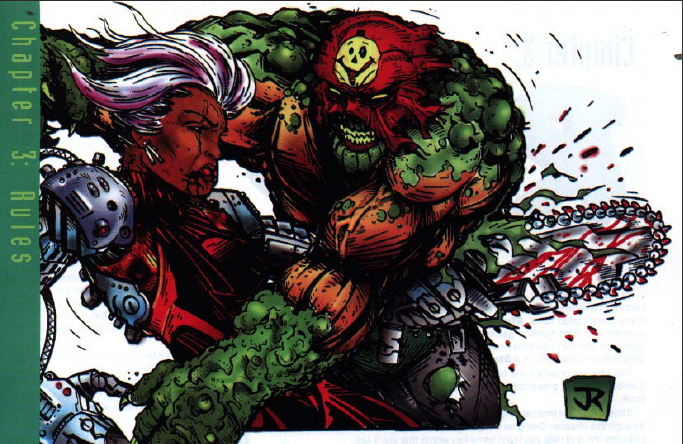
This fight was approved by the Latveria State Athletic Commission
Now we come to the basic game mechanics. If you’ve played other White Wolf Storyteller games, most of this is familiar.
Time is divided into several units:
Turn: Three seconds to three minutes; long enough to take one action. (In combat, of course, it’s closer to the former.)
Round: Ten turns. Most formal duels last one or two rounds.
Scene: A narrative unit which explains itself; all the action that happens at one location.
Chapter: Basically, one game session.
Story: A narrative with a beginning, middle, and conclusion; a plot taking multiple sessions to resolve before moving on to the next story.
Chronicle: White Wolf’s artsy term for a campaign.
Ratings and dice
Again, like other Storyteller games, Street Fighters have Attributes and Abilities ranking from 1-5, and a few traits (like Chi and Honor) which can go to ten. Most non-combat rolls are made by totaling an Attribute + Ability, rolling that many d10s, and counting a “success” for each die that meets or exceeds the Difficulty (2-10) set by the Storyteller. They make the same mistake here as a lot of other games—there is of course a list saying that 6 is “Standard” difficulty and 9 is “extremely difficult,” but what’s a standard difficulty for a firebreathing ninja gladiator?
Street Fighter also has the Rule of One—any 1s rolled subtract from successes. Rolling net negative successes results in a Botch, a disastrous result. The Rule of One is stupid and results in stupid math where your probability of success wavers oddly with lots of dice, and you’re very likely to roll at least one 1 which adds an annoying bookkeeping step, but I’m not going to whip out the charts on you.
There’s also Automatic Success, which means if you have X dice and the Difficulty is X or less, you can take one automatic success. Slow and steady wins the race.
There are also Extended Actions (roll a required number of successes in a given number of turns), Resisted Actions (roll more than your antagonist) and Teamwork (group rolls individually but adds successes).
Street Fighter, Chapter 3: Character Creation, Part 1
This is going to be fun.
New characters in Street Fighter actually aren’t all that different, in concept, from those in World of Darkness games where you play humans-turned-monsters: Although you can create a fighter of any age, nationality, or style, you begin the chronicle as an inexperienced fighter who doesn’t know much about Street Fighter society beyond what your Sensei has explained to you.
I’m definitely going to create a character as part of this chapter review; maybe a couple. I just realized that Fighting Style is a big part of the character and I don’t want to decide myself. I hereby solicit choices from the Fatal & Friends readers. Your choices are: Capoeira, Kabaddi, Kung Fu, Native American Wrestling, Sanbo, Shotokan Karate, Special Forces Training, Sumo Wrestling, Western Kickboxing, and Wu Shu. (The bad guy boss characters’ styles aren’t available.)
Character Creation
Original SA post Street Fighter, Chapter 4: Character CreationPart the second! Now that we understand the basics of how we roll dice, we’re ready to create a character. Two characters, actually—the voice of the people demands a Sanbo wrestler and a Kabaddi yogi.
(As an aside, I discovered that Kabaddi is a real thing. It's an Indian team sport where you score by crossing the field, tackle an opponent, and run back across the line without getting tackled yourself. Like a cross between Red Rover and rugby.)
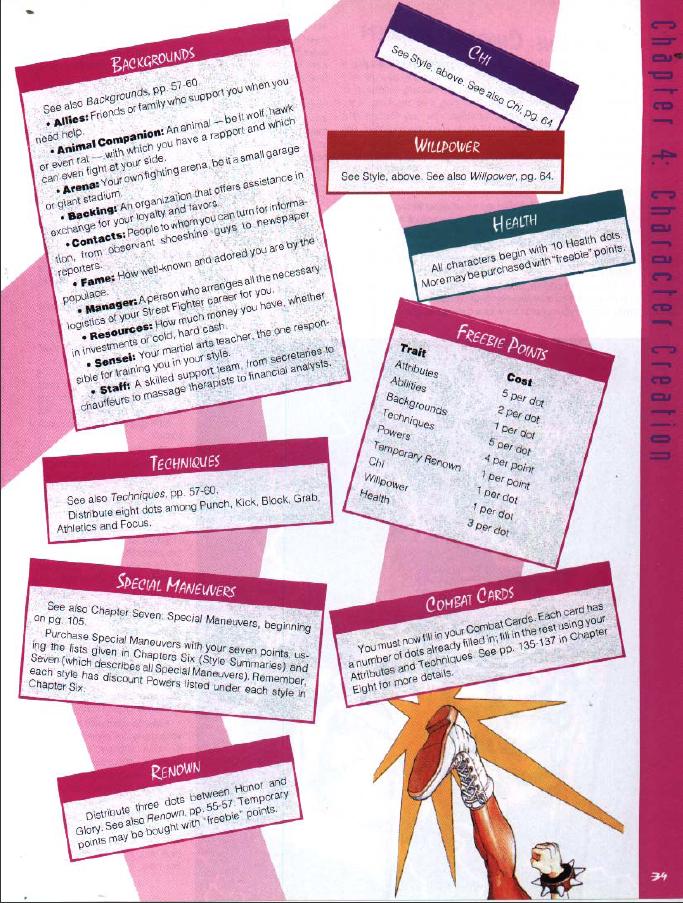
Concept
The first step of character creation is to come up with a character concept, which serves as a base that we can slather in all sorts of kung fu sauce.
El Rey Pingüino grew up in rural Mexico, and was one of the many people displaced to poor neighborhoods of Oaxaca when M. Bison seized control of the Thunderfoot tribal lands. Determined to make something of himself, Rey began as a street entertainer for the amusement of tourists before being accepted into a lucha libre gym. He was hardworking and talented enough to be included on a wrestling tour of Japan. In Japan, he saw the great Russian wrestler Zangief in two matches—first, in a worked match in a pro wrestling ring, and second, in an underground Street Fighting tournament, for which the staged matches were merely a cover. After seeing Zangief win his marquee fight, Rey decided that Sanbo was indeed the strongest, and stayed in Japan to study under a Sanbo trainer who had emigrated there. After being deemed skilled enough to strike out on his own, Rey realized that while he had come very far from humble beginnings, he had done so by thinking only of himself. Returning to Oaxaca, he continued to wrestle worked matches as a masked luchador, but also began to donate portions of his earnings to local orphanages and posit himself as a role model for poor children like himself. His personal drive undiminished, he vowed to surpass even the great Zangief. Aspiring to be greater than a man who earned his scars by wrestling Kodiak bears, he took as his personal totem an animal that thrives in the chilly Antarctic, where even bears cannot survive. El Rey Pingüino lucha para los niños.
Stormy is the product of a broken home. At 14, she left her meth-addicted parents and joined up with a crew of crustpunk kids, hopping trains from city to city around the United States. Eventually she found herself, totally by accident, in a community where she actually felt like staying for awhile—an ashram commune for Hindu spiritualists. She got into yoga and meditation, and managed to calm the hair-trigger temper that earned her the nickname she used when riding the rails. She also learned Kabaddi, the mysterious martial art of mystical yogis. Eventually wanderlust got the better of her, and she left the only community where she’d ever felt accepted—and fell into street fighting when she needed bus fare. Stormy doesn’t love fighting, but she doesn’t hate it either, and being a Street Fighter is the closest thing to a career that’s ever appealed to her—traveling from city to city, living by her wits, doing something she’s good at.
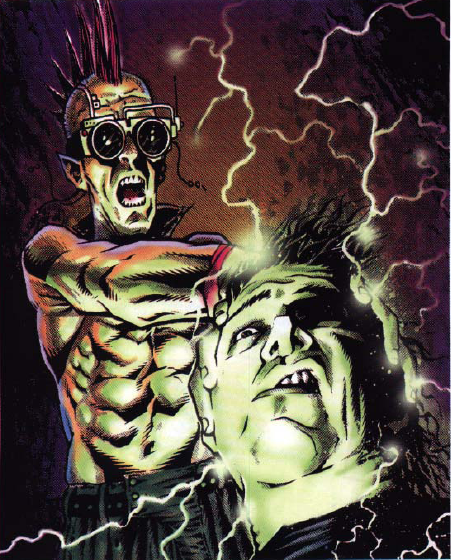
”I said, tell me how to get back to Shadowrun, motherfucker!”
Style
Street Fighter asked you to choose your Style even before you allot points to your basic Attributes. Your Style determines what maneuvers you can learn, yes, but even before that, it determines your starting Chi and Willpower.
Rey is a Sanbo fighter; he starts with a measly Chi of 1, but a Willpower of 6. Clearly he’ll be relying on grit and brawn to slam faces into the pavement.
Stormy is a Kabaddi fighter; she starts with a Chi of 5, but a Willpower of only 2. Hopefully she’ll be able to make the most of that with some mystical aces up her sleeve.
Attributes
Okay, here’s where the balance issue rears its ugly head. Like all the old World of Darkness games, Street Fighter has 3 Physical, 3 Social, and 3 Mental Attributes, and asks you to prioritize the categories as Primary (7 points), Secondary (5 points), and Tertiary (3 points). Most of the time, the stats for your Maneuvers in fights are going to be based on your Physical Attributes, so almost all players are going to prioritize Physical Attributes.
This is the kind of thing that happens when you use a generic system base to make a game that’s all about fighters and fighting.
Rey is going to go the minmaxing (but, admittedly, totally sensible) route and take Physical Attributes as his primary category, Social as secondary, and Mental as tertiary. Characters start with one dot in every Attribute, and I spend the points like so:
Physical : Strength 4, Dexterity 3, Stamina 3
Social : Charisma 3, Manipulation 3, Appearance 2
Mental : Perception 2, Intelligence 2, Wits 2
Stormy is a scrappy kid, and a skilled yogi, but her biggest asset is between her ears. However, her troubled past hasn’t made her the most sociable person in the world. Her priorities are Mental, Physical, and Social, and I spend the points thusly:
Physical : Strength 2, Dexterity 4, Stamina 2
Social : Charisma 3, Manipulation 1, Appearance 2
Mental : Perception 4, Intelligence 2, Wits 4
Abilities
Abilities are the skills of Storyteller games (except that’s a subcategory). Talents, which are innate, Skills, which are a matter of learning and practice, and Knowledges, which are just that. You have to prioritize them 9/7/4, however you choose. This is fewer points than you get in other Storyteller games from the old World of Darkness era, but there are only 6 skills in each category.
Rey’s education, such as it was, was mainly about making the most of the things he was naturally good at. He received little formal education, but he knows more about the Street Fighting world than most rookies. His priority is Talent/Knowledge/Skill, spent like so:
Talents : Alertness 2, Insight 3, Streetwise 3, Subterfuge 1
Skills : Stealth 2, Survival 2
Knowledges : Arena 2, Investigation 1, Mysteries 2, Style Lore 2
Stormy is a jack-of-all-trades who’s had a lot of life experience living on the road and rails. She doesn’t know much about the world of Street Fighting of which she’s now a part. Her priorities are Talent/Skill/Knowledge, spent like so:
Talents : Alertness 2, Intimidation 2, Streetwise 3, Subterfuge 2
Skills : Drive 1, Security 1, Stealth 2, Survival 3
Knowledges : Computer 1, Medicine 1, Mysteries 2
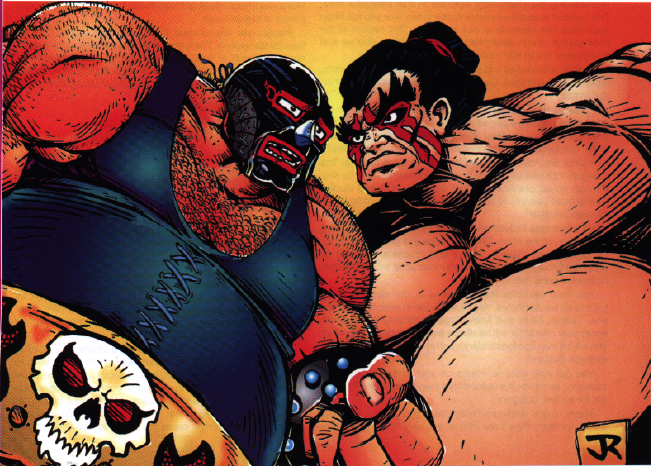
Loser pays for the winner’s next chest wax.
Advantages
Here’s where we start getting into the nitty-gritty of what makes Street Fighters unique. First, though, are Backgrounds, which aren’t unique to Street Fighters, and represent resources external to the character, like friends and money. Starting characters get 5 points of Backgrounds.
Rey puts 2 points in Arena, meaning that he owns someplace suitable for hosting fights. Two points is enough to represent a respectable small gym with a wrestling ring. He puts 2 points in Resources, a respectable steady income, and 1 point in Fame, to represent the reputation he’s gained as a talented luchador.
Stormy has little in the way of material possessions. She puts 1 point in Contacts, for the source of information that introduced her to underground street fighting, and 2 points in Sensei, for the yoga master who will still train her when she has time to return to meditation and solitude. She also puts 2 points into Animal Companion--that’s Sparky, an unusually smart and well-trained labrador who is her constant traveling companion.
Now that that’s out of the way, the real bread-and-butter of a Street Fighter’s abilities-- Techniques ! You probably noticed that there’s no “Brawl” ability in Street Fighter. Fighting ability is purchased separately and differently from Abilities, broken up into eight different Techniques: Punch, Kick, Block, Grab, Athletics, and Focus. These are mostly self-explanatory. Points in a Technique aren’t just used to make attacks, but as prerequisites for Maneuvers you want to learn--you can’t learn Zangief’s Spinning Clothesline until you have Punch 4 and Athletics 3, for example, meaning that most of the signature moves of the World Warriors are out of the reach of starting characters. This doesn’t mean that starting characters are boring, though, or that you don’t know any of the same moves as the big boys. If you’ve played Super Street Fighter II and the games that came before it (and probably quite a few that came after) you’ll definitely recognize some of the World Warriors’ distinctive moves--you’re not ready to crack skulls with Zangief’s Spinning Pile Driver or Bison’s Scissor Kick, but things like Piledrivers and Slide Kicks are definitely within reach.
The prerequisites system also means that you’ll eventually want to invest points in Techniques that aren’t your primary means of attack. Even if you never plan on throwing a Fireball, you’ll need some points in Focus to master Maneuvers like the Flash Kick or Flaming Dragon Punch. You start with 8 Technique points.
Rey subscribes to the theory that the best defense is a good offense; he rushes in, batters the enemy, and then pins them to the mat.
Punch 2, Kick 0, Block 1, Grab 3, Athletics 2
Stormy balances her fighting instincts with a calm, collected approach to fighting. She eschews getting in close and trading punches, for fear of getting crushed or slammed by a bigger opponent. She prefers to use mobility and good defense to wear the opponent down.
Punch 0, Kick 2, Block 1, Grab 0, Athletics 2, Focus 3
Now that we’ve established the basics of where our fighters’ skills lie, it’s time to buy some Special Maneuvers . (All fighters can perform 8 Basic Maneuvers: The Jab, Strong, and Fierce punches and kicks, a basic Grab attack, and Block.) Maneuvers cost Power Points; you start with 7 and can get more with experience points, like everything else.
Besides determining your initial Chi and Willpower, this is where your Style becomes really, really important: Each style has a Maneuvers list associated with it. Some of these Special Maneuvers are on the list because your Style gives you a price break in Power Points. Some are on the list because you can’t learn the move at all if you don’t have the right style. For some examples: the Backflip Kick Maneuver has a cost of Capoeira and Wu Shu 2, Kung Fu and Special Forces 3, Any 4. (Meaning the first two styles get it for 2 points, the second two for 3 points, and anyone can buy it for 4 Power Points.) On the other hand, the Dragon Punch can only be learned by Shotokan Karate fighters for 4 points and Kung Fu fighters for 5 points. The terrifying Storm Hammer slam can only be learned by Native American Wrestlers, and for 5 Points. (No Maneuver ever costs more than 5 Power Points).
I’m not going to go into detail on all the Maneuvers until we actually get to that chapter, so I’m just going to pick some good Maneuvers for our fighters and leave some things up to your imagination.
Rey buys the following Maneuvers:
Spinning Backfist (Punch, 2 points. This is like a Fierce bunch with better Move, so he can keep opponents guessing--if they dart back to avoid a Grab, he can steamroll them with a hard Punch.)
Jump (Athletics, 1 point. Vital for quick movement across the arena, and it can be used to dodge projectiles.)
Air Smash (Athletics, 1 point. A slow, but far-reaching leap attack that can also dodge projectiles. You can take the luchador off the turnbuckle, but...he will land on you.)
Suplex (Grab, 1 point. It’s a suplex.)
Thigh Press (Grab, 2 points. It’s a Frankensteiner. Seriously, that’s what it is. Never mind that it’s sexier when Cammy does it.)
Stormy buys the following Maneuvers:
Slide Kick (Kick, 2 points. A trusty Dhalsim Maneuver that’s not too slow, hard-hitting, has good range, and scores a Knockdown. What’s not to like?)
Jump (Kick, 1 point. See above.)
Fireball (Focus, 3 points. Yes, I bought Fireball as a starting character. More on that in a minute.)
Since there’s nothing else Stormy wants that only costs 1 Power Point, I decide to spend the last point on a C-c-c-combo Maneuver! For the cost of a Power point, you can link two moves together in a Combo. What that means is that after performing Maneuver 1, if you perform Maneuver 2 in the following round, it gains a +2 speed bonus. For another Power point, you can link a 3rd maneuver after the second. You can also spend a Power Point on a Combo to make it a Dizzy combo, so that damage from all the maneuvers will stack to determine whether or not the opponent is Dizzied. (More on that later.) Buying a combo is for a distinct sequence: Buying Block to Fierce Punch to Tiger Knee doesn’t give you the bonus if you do Fierce Punch to Tiger Knee to Block . The combo is b-b-b-broken if you get knocked down or Dizzied, of course. Mostly, you want Combos to use fast attacks to set up slow, powerful ones.
Now, regarding Stormy’s Fireball--here’s another area where bad balance shows up in Street Fighter. It’s not that a starting character with Fireball is brokenly powerful; quite the opposite. I boosted her Focus to 3 and bought Fireball because there’s not much else for her to do with her Focus powers. Unlike Punch, Kick, Block, and Grab, there aren’t many “entry-level” Special Maneuvers for Focus, and the ones that are there aren’t very good for a one-on-one fight. Kabaddi gets a price break on a lot of Focus Maneuvers, but most of them are pretty expensive--and the fact that they have very, very few breaks on non-Focus maneuvers means that you’re better off either doing what I did, or playing a kickboxer with cheap “Any 2” Maneuvers for a while before you buy a high Focus. In either case, you’ll suffer from being either a one-trick pony, or a mediocre character who is paying a premium for Maneuvers and shunting Experience into a Focus Technique he won’t really be using for a good long while.
Oh, and did I mention that Focus Maneuvers use Wits instead of Dexterity to determine their Speed, and Intelligence instead of Strength as their base damage? So you’re dividing your Experience between two different sets of Attributes, too.
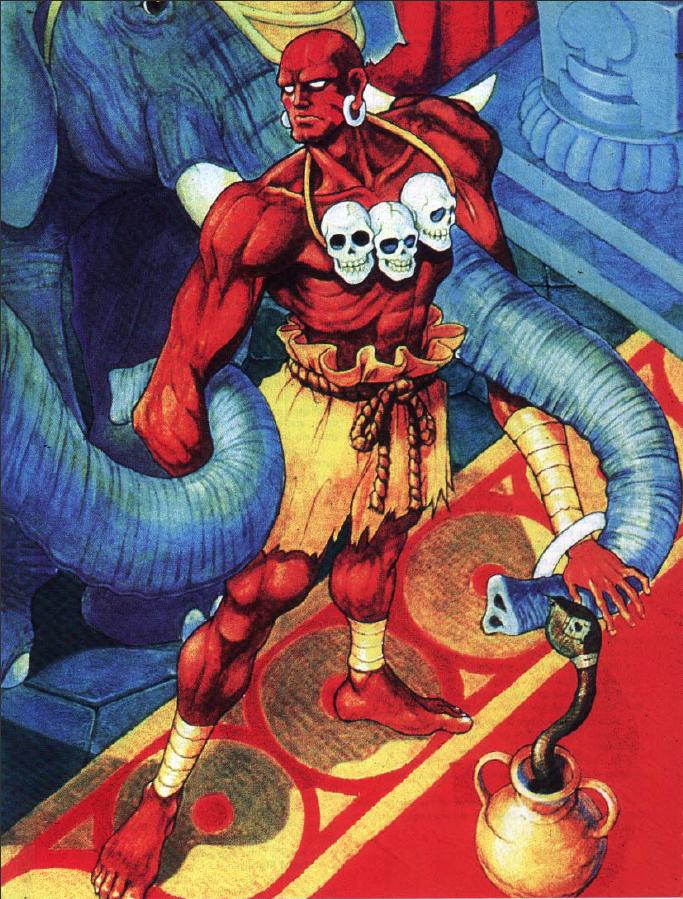
This man is an internationally-famous athlete. And married. Can’t his wife talk him into wearing some shorts?
Okay, balance rant over! The next step is Renown . Beginners get 3 points to distribute between Honor and Glory.
El Rey Pinguino is a showman in the ring, and while a good sportsman, hasn’t had the occasion to showcase his honorable fighting style. Glory 2, Honor 1.
Stormy, while hot-tempered, has a reputation as a cool customer in the ring--on the other hand, her blast-and-run style doesn’t exactly endear her to fans of bloodsport. Honor 2, Glory 1.
Both characters start with 10 Health points. Yes, these work like they do in World of Darkness Storyteller games, although there are never any wound penalties. Yes, they start with 10 points. Yes, then can go all the way up to 20 with Experience.
Now both our fighters get 15 Freebie Points! These can be used to buy other traits to round out your character.
El Rey spends 5 points on a point of Dexterity--it’s good to be a fast grappler, as your grappling attempts will get spoiled if your opponent hits you and then steps out of range. He also spends 5 points on another point of Block. He also spends 3 points for an extra point of Health. Finally, his last 2 points go into hiring a decent Manager (a Background) to handle his burgeoning career.
For Stormy, let’s say that the settled life she enjoyed for a time led her to discover her neglected natural Intelligence--another point there, for 5 Freebies. Since her Fireball costs Chi to use, we may as well spend 5 points to raise her Chi pool from 5 all the way to the maximum of 10--a very good buy! Finally, it’s advisable to buy her another point of Block, since concentrating on Focus-related things has left her defense a little shabby. Yes, I’m minmaxing; fuck you.
Last is Rank. Characters start with Rank 0, and no wins or losses that are on record. Each Street Fighter earns Rank in one of 3 Divisions: Traditional, Freestyle, and Duelists. Traditionalists are martial artists who shun exotic powers, which is a good fit for plenty of fighters, but you can’t actually enter the Traditional Division until your Honor is at least 5, which makes it somewhat redundant. Freestyle tournaments allow any powers and abilities a fighter develops on his own. Lastly, the Duelists are the Extreme Championship Wrestling version of Street Fighter--they allow melee weapons and even trained animals. El Rey and Stormy both start in the Freestyle Division.
After actually statting your character, the book gives a couple of pages of advice (for both the player and the Storyteller) on how to give the characters a “spark of life” and integrate as a team. It encourages each player to answer questions for the character about where they were born, who taught them martial arts, why they got into Street Fighting, and so on. It also advises a brief “prelude,” a one-on-one session between the ST and each player to establish their character in the campaign. It also has a short section on establishing the team’s motivation; namely, why they’re together. The two biggies are, of course, “to enter tournaments” and “to get revenge on Shadoloo.”
El Rey Pinguino:
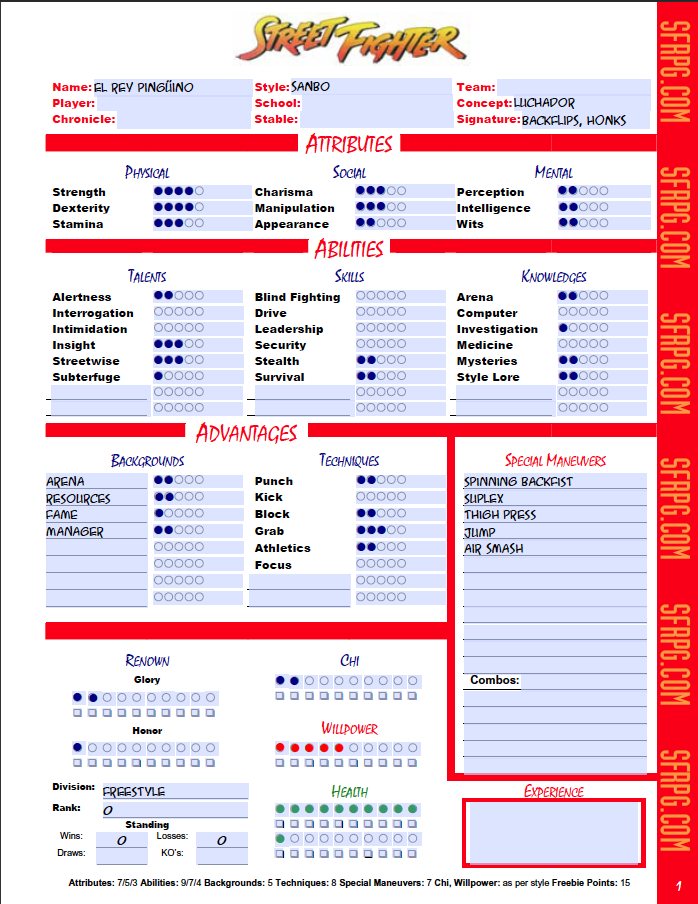
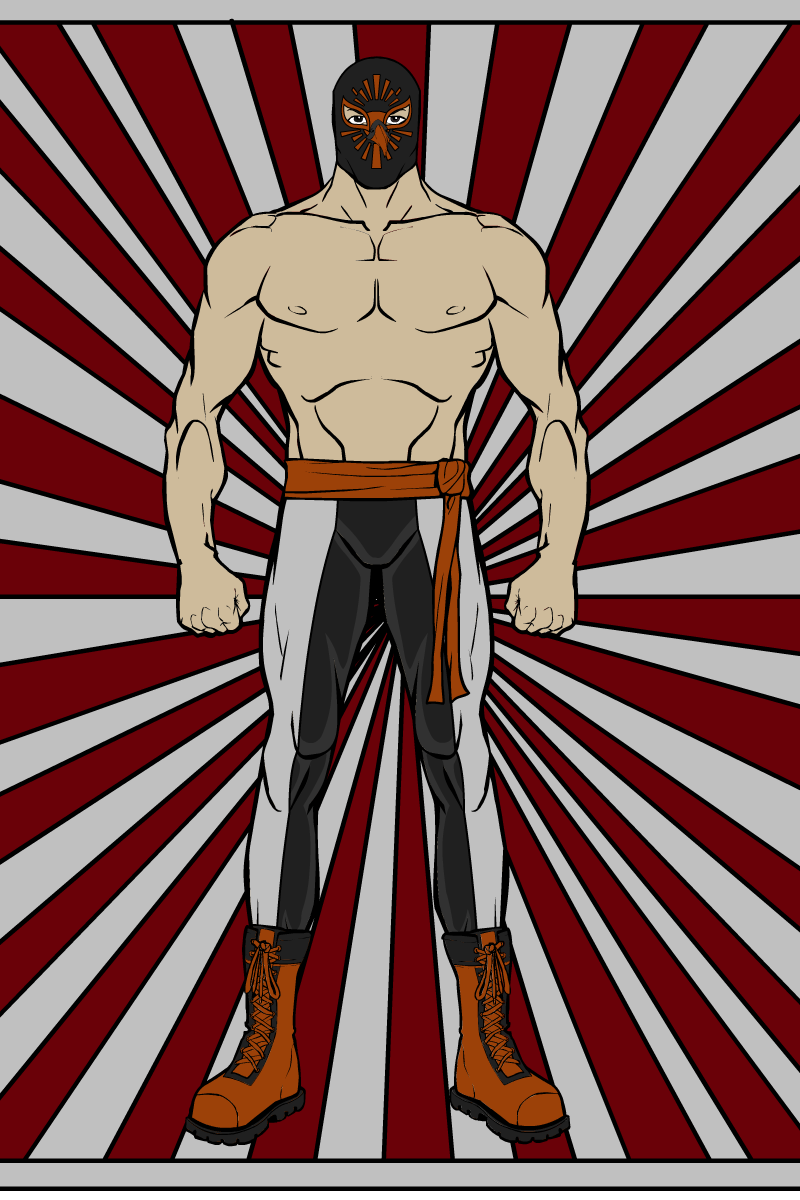
Stormy:
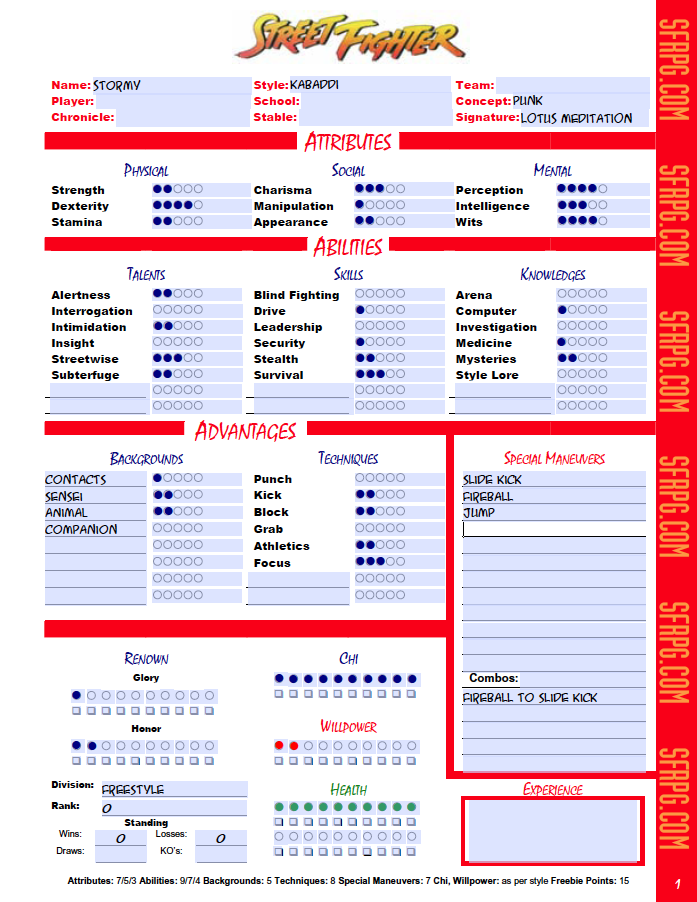
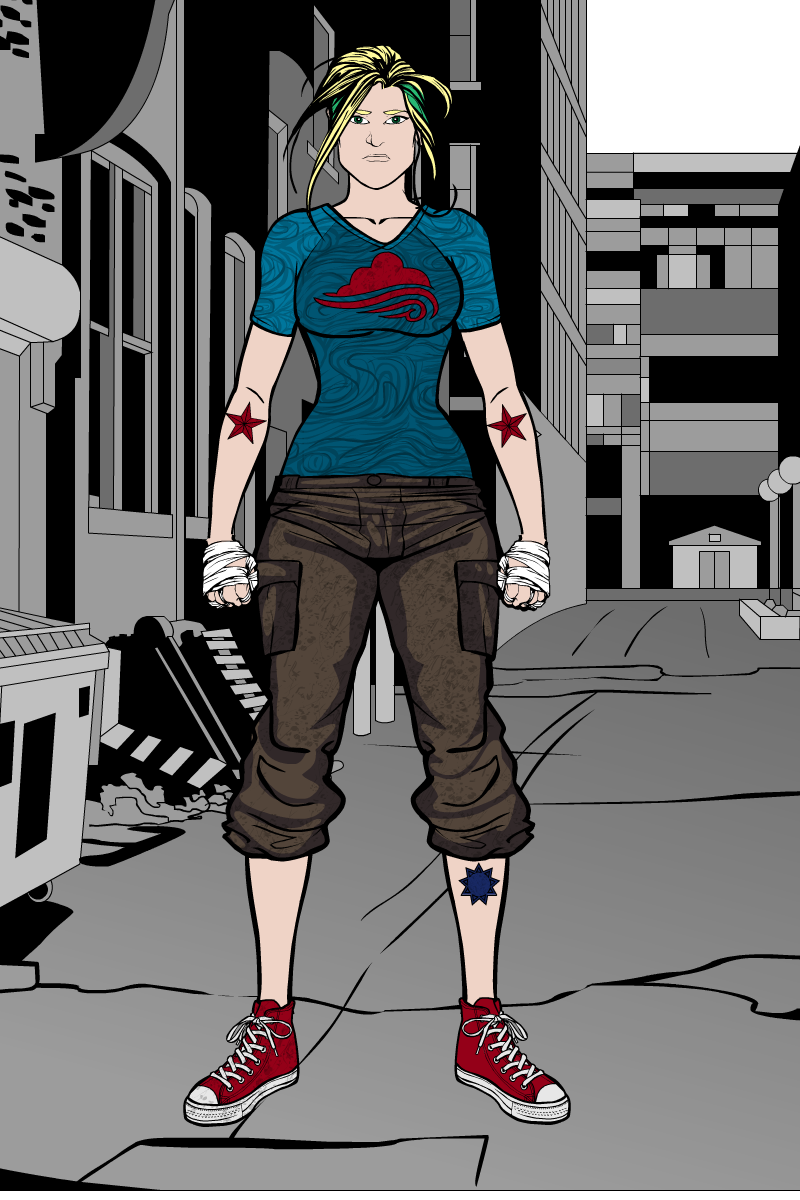
Traits & Systems
Original SA post
I know it was a long layoff, but I'm back with more Street Fighter.
Here
is the last entry, on character creation.
Street Fighter, Chapter 5: Traits and Systems
This chapter is inherently kind of boring; it lists the traits the characters can have and what they do. Mainly what I'm going to be doing in the chapter is kind-of explaining why certain traits are worth having, and why the game doesn't live up to its concept in others. Oh, and apologies for the lack of awful art in this chapter to share with you.
Attributes
Street Fighter uses the classic 9 attributes from all the World of Darkness games.
Strength
: Self-explanatory. Determines the base
Damage
of your Maneuvers in combat.
Dexterity
: Agility, hand-eye coordination, blah blah blah. Determines the base
Speed
of your Maneuvers in combat.
Stamina
: Toughness and endurance. Determines the base
Soak
you roll to negate damage when hurt.
Charisma
: Used for drawing people to you and gaining others' trust. It doesn't add directly to your Renown or anything, and you hit people in the face for a living, so who cares?
Manipulation
: Used to actively influence others; you don't have to be trusted or likable to have a knack for convincing others to do anything. But you should be convincing people to do things by hitting them, so who cares?
Appearance
: Your Comeliness score. You either want this to be low (because you wish you were Zangief) or high (because you wish you were Chun Li, or owned a RealDoll of Chun Li).
Perception
: Your general situational and sensory awareness.
Intelligence
: Your capacity for learning and thinking. For some reason Intelligence, rather than Strength, determines the
Damage
of Focus Maneuvers; apparently a high IQ makes your Fireball hotter.
Wits
: Cleverness and ability to react quickly to unfamiliar situations. For some reason, it determines the
Speed
of Focus Maneuvers instead of Dexterity.
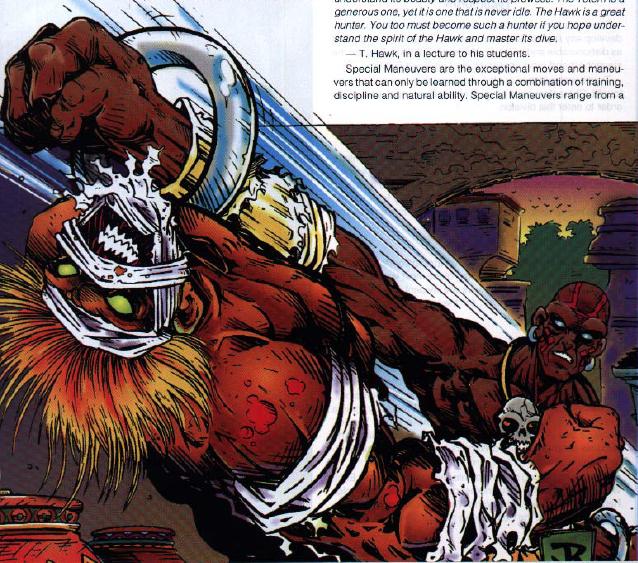
On reflection I'm so glad SF4 went with "Slutty Taekwondo Mallgoth" instead of "Heavy Metal Eczema Mummy"
Abilities
Abilities are the Skills of Street Fighter. Unfortunately, Street Fighter really only has Abilities that directly relate to being a Street Fighter and/or international adventuring crimefighter in some way; granted, you might think it's not really necessary to roll Science or Business, but it might be nice to have those available, no?
Talents
Alertness
: This is your standard D&D "perception check" skill.
Insight
: Your ability to size up an opponent. If you observe an opponent for at least 3 rounds, you can roll to determine their style; each additional success gives you a peek at a random card (more on that later) from their Maneuvers list.
Interrogation
: Covers everything from investigative reporting to brutal torture. There is a proviso in losing permanent Honor points for the latter, though!
Intimidation
: For threats and coercion. You can roll this before combat to reduce an opponent's Speed for the first turn.
Streetwise
: Blending in, tracking down unsavory individuals, and buying drugs. Sweet, sweet drugs.
Subterfuge
: How to read people's hidden motives, and hide your own.
Skills
Blind Fighting
: Sensing opponents you can't see. I don't think that the book even gives you rules for how to use this. So it's a highly situational skill with no clear use, the Philosophy major of kickassademia.
Drive
: You can drive a car "and perhaps other vehicles as well." Probably meant to be used for action movie car chases; ironically, this book doesn't have any guidance on how to do that, even though Vampire does.
Leadership
: You can exert authority and get people to follow your command! I'm not sure how often you will use this. No, there are no rules for hirelings or mass combat in this game.
Security
: One of your Rogue skills. Picking locks, disabling security systems, and other cool Mission Impossible shit.
Stealth
: Your other Rogue skill; hiding and sneaking. Important if you're playing a Neenja. (Note: Book contains no ninjitsu rules.)
Survival
: Survival in the wild! Might come in handy while tracking down an ancient arena or Shadoloo base in the jungle.
Knowledges
Arena
: An interesting skill; this means that you are familiar with the most notable Street Fighting arenas around the world, and who owns them and sponsors the tournaments. There's no specific rules for it, but it can allow you to prepare for home-turf advantages like Vega's cage walls.
Computer
: Represents general knowledge of computers, but be honest, you're going to use this for action-movie hacking and nothing else.
Investigation
: Represents both police investigation and general research ability. An important skill, since Street Fighter campaigns are generally about fighting crime when they're not about kicking faces.
Medicine
: Giving medical attention. Represents everything from first-aid to being an actual doctor. I feel the need to point this out: One dot has the tagline "Mother of small children," four dots is "school nurse" and five dots is "Paramedic." Apparently they either think that being a school nurse or paramedic means you're a medical expert, or that no Street Fighter will ever actually rise to the level of a genuine MD.
Mysteries
: This is your catch-all "Occult" skill. How it relates to Street Fighting lore is not explained at all.
Style Lore
: Exactly what it says. Again, there are no prescribed rules for it, but you can use this to identify someone's style.
Renown
Glory
and
Honor
are the two aspects of Renown, which are ten point pools. Glory represents accomplishment and daring, while Honor represents ethics and sense of duty. Honor works like Willpower and Health in that you have a Permanent rating and Temporary dots. In order to gain Permanent Renown, you have to raise your Temporary pool to 10, and maintain those ten dots for the next session; then you automatically empty your Temporary rating and gain a Permanent point.
Unfortunately, the benefits of Honor are concrete while the benefits of Glory are vague. You can roll your permanent Honor to regain a point of Chi or Willpower (your choice) per success. Glory is supposed to earn you opportunities as a Street Fighter--better managers, invitations to classy tournaments, training with sought-after Senseis, and so on.
(How dishonorable mystic warriors maintain their high Chi is a mystery; clearly Bison is a psychopathic bastard but has scary Chi leaking out his pores.)
There's a list of things you can do to earn or lose Renown, though of course it's ultimately up to Storyteller discretion.
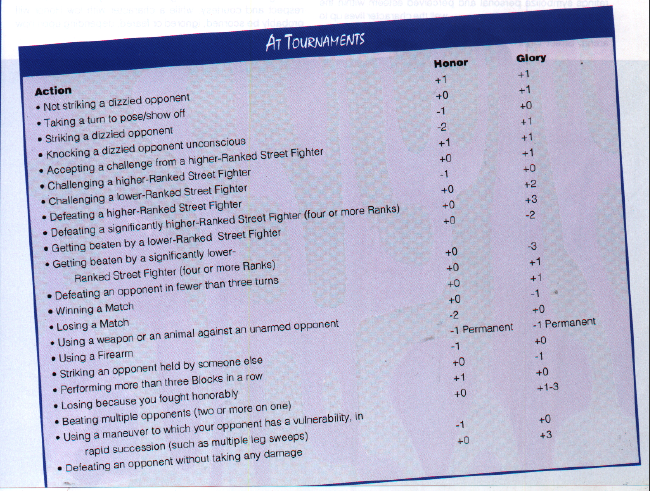

Obviously, the most effective way to earn a pile of Honor and Glory is in the midst of a fist-fight.
Advantages
Advantages are just that, special qualities that you have, mostly external to you.
Backgrounds
Allies
: Allies are competent friends/family who will support you when you need them. Each dot represents one Ally of significant skill, or fewer Allies of great power. There's not much of a guideline for how powerful an Ally should be.
Animal Companion
: Animal companions are kind of neat. A one-dot companion is a tame and well-trained house pet, like Lassie or something, but that's it. More dots represent an animal that's rare or unique, and a level of "empathic rapport" with the animal. That isn't represented mechanically unless you have 5 dots, which means you have a unique animal and can even see through your companion's eyes.
Arena
: This represents owning an Arena that can host Street Fighter tournaments. A one-dot Arena basically means you set up a ring in your garage or something, two-dots is like a standard gym or dojo. A five-dot Arena is a grand venue that could host a World Warrior tournament with lots of spectators, like Han's private island from
Enter the Dragon
. Of course, it doesn't mean that you have the wealth or contacts to make that happen.
Backing
: Backing means that you are supported by an organization--maybe you're a secret agent, or your Street Fighter career is sponsored by a corporation. There are some rough guidelines on what Backing provides; low dots means they take care of things like travel and lodging, whereas more dots means your livelihood is automatically provided and you probably have some kind of authoritative status in the organization. Part of Backing, though, is being expected to do things for your organization; Backing 5 basically means that you are a well-supplied, well-paid full-time agent.
Contacts
: As opposed to Allies, Contacts are people you can call on for information. A standard dot of Contacts represents one source with limited information.
Fame
: This represents a general celebrity kind of fame, as opposed to being renowned only among Street Fighters. One dot means you're well-known to a subculture (like Hong Kong action film buffs) whereas 4 or 5 dots means you are as well known as a famous actor or politician. Street Fighting is popular enough in the setting that most of the World Warriors have some points in Fame.
Manager
: A manager is someone who takes care of your travel, gets you booked for fights and training, negotiates your pay, and otherwise takes care of the business side of being a Street Fighter. There is some sketchy information on what a good manager can do for you, but again, not a lot of info on how this is supposed to be relevant to the story, or what to do if one character has a great Manager but no one else does.
Resources
: You've got money, honey. It's left to you to determine where your money comes from and if you actually have to hold down a day-job to maintain it. One dot represents a small income, five dots is multimillionaire territory.
Sensei
: You have a teacher who can instruct you in the Special Maneuvers of your style. He doesn't save you a cost in Experience points, but allows you to buy the Maneuvers in the first place. The rating represents the Sensei's quality and accessibility.
Staff
: These are people who are there specifically to help you with aspects of your fighting career: Ring doctors, personal trainers, even chauffeurs and cheerleaders. However, there are no rules given for what benefits they actually provide, if any. The entry suggests you could even build a chronicle in which one person plays a Street Fighter and the other PCs are staff members, but I have no idea why you'd want to do that. This isn't the
Buffy
RPG.
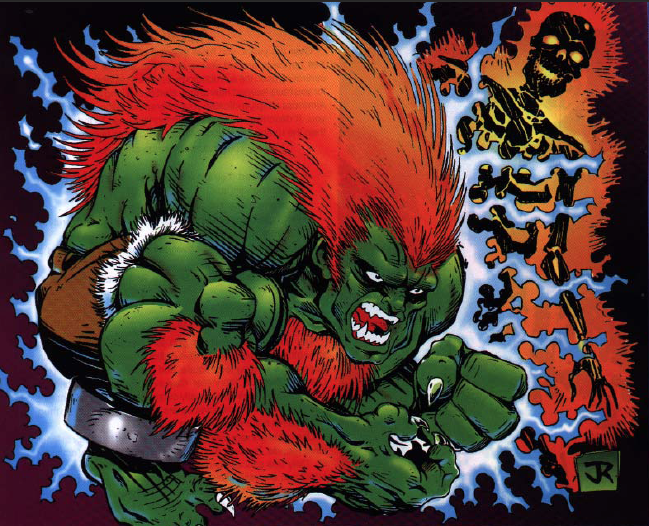
Blanka gives Hornswoggle what's coming to him. It's not easy being green.
Techniques
These are the traits that power your Maneuvers. For Maneuvers that do damage, your Technique rating adds to the base, and you need a certain number of dots in some Techniques in order to learn the higher-level maneuvers.
Punch
: Punching. You'll need this to learn techniques like the Dragon Punch, Hundred Hand Slap, and Master Jackson's funky ninja-crippling Dim Mak.
Kick
: Lightning Leg. Flash Kick. The entire spectrum of foot-to-face science.
Block
: Blocks, as a rule, don't do damage. When you Block, you take the hit but add your Block rating to your Soak. There are specialty Block maneuvers, though, none of which are from the video games.
Grab
: Grabs are often hard to pull off; they usually have a Move rating of "One" and require you to move into your opponent's hex, meaning you need to sucker them into standing next to you instead of playing hit-and-run. But they can also do insane damage. Covers everything from Ken and Ryu's back roll throw, to Blanka's Head Bite, to terrors like the Storm Hammer and Spinning Piledriver.
Athletics
: There are Athletics Maneuvers that do damage, like the Cannon Drill and Flying Headbutt, but more importantly, all Street Fighters use their Athletics rating as the base Move for all their Maneuvers. A lot of high-flying Punch and Kick maneuvers also require some dots in Athletics.
Focus
: Oh, poor little Focus, you make it so hard to play a Street Fighter specializing in you. Most of the Focus maneuvers that actually do damage, like Fireball, aren't readily available to starting characters, and Focus maneuvers are hampered by the fact that they use Intelligence and Wits instead of Strength and Dexterity for their base Damage and Speed, creating the problem known to D&D players as "multiple attribute dependency." Still, almost everyone will want to invest some points in Focus at some point, because you'll need at least a couple dots of Focus to learn maneuvers like the Flash Kick and Flaming Dragon Punch.
Rank
Rank isn't something you really need a subsystem to gain or lose, like Glory and Honor. You gain Rank by fighting and winning matches--each Rank has a minimum number of matches fought and a required win/loss ratio. All the World Warriors are Rank 9 or 10. Rank 10 requires at least 60 matches fought, and a 20:1 win/loss ratio. As explained in the last chapter, Rank is earned in one of three divisions: Traditional (no fireballs), Freestyle (no weapons or other dirty tactics), and Duelist, which typically allows weapons and fighting animal companions, can have different rules from tournament to tournament, and is basically the hardcore garbage wrestling of the Street Fighter circuit.
Disposables
They do actually call them that. Chi, Willpower, and Health, like Renown, have a Permanent rating and a Temporary rating, but you can't have more Temporary points than your permanent Rating.
You spend Chi and Willpower to fuel Maneuvers. (Most Maneuvers don't cost Chi or Willpower at all, but a Flaming Dragon Punch or Siberian Suplex is a different story.) Generally, Maneuvers will cost 1 Chi, 1 Willpower, one of each, or two of each, and no more.
Willpower
: Fortitude, dedication, and inner resolve. Willpower is usually spent on Maneuvers that require you to dig deep for an awesome display of physicality, like Sanbo suplexes.
Chi
: Attunement to mystical lifeforce within the body. Chi is typically used to power blatantly supernatural Maneuvers like Guile's Sonic Boom and Flash Kick.
Health
: All Street Fighters start with 10 dots of Health, and you can buy your Permanent rating up to 20. When you take enough damage to reduce your Health to 0, your ass is knocked out. You can recover all your Health in, I'm not kidding, 15 minutes of rest. If your Health was reduced below 0, you take those excess points as Aggravated Damage that takes a full day to heal per point, instead. So, if we're doing a two-round fight, and you have 2 points of Health but Sagat wallops you with a Tiger Knee for 8 points of damage, you start the next round already at 6 points below your maximum--ouch. Of course, as a Storyteller I'd call that an Honor offense, not that Sagat cares!
There are
deliberately
no rules for death in Street Fighter. Only the Storyteller can make that call.
The chapter closes with the rules on Experience, which are pretty simple, and lists the chart for what it costs to raise your Traits. It also notes that it's possible for experienced characters to raise their Attributes, Abilities, and Techniques above 5, though it costs a boatload of points. You can never, ever increase a Trait above 8, though, and that's crazy anyway--Balrog has Punch 7.
Next time, on Street Fighter: The Fighting Styles of the World Warriors!
The Fighting Styles of the World Warriors
Original SA post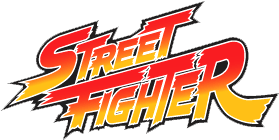
Street Fighter, Chapter 6: The Fighting Styles of the World Warriors
This chapter provides 10 Styles, along with character sheets for the World Warriors who practice them. The book is up front about the fact that a Street Fighter's Style determines a whole lot about the character. In game terms, it determines your initial Chi and Willpower, and what Special Maneuvers you can learn, and at what cost. (Want to knock faces off with a Sanbo Dragon Punch? Sorry, but you can't ever learn that unless the Storyteller allows it.) Fighters who casually switch styles, it says, never learn the Maneuvers that set World Warriors apart from the also-rans.
In cases where the styles listed here have an actual real-world equivalent, I'm just going to give you the style as it is in the Street Fighter universe (and in the minds of the White Wolf staff who probably didn't do much research). I'll leave the chopsocky accuracy rage to you, readers.
Before we get into the styles, let me remind you how Maneuvers lists work: Some Maneuvers can be learned by anyone, but some styles get a break on the Power Point cost. Really good maneuvers (like the Dragon Punch or Siberian Bear Crusher) can only be learned by one or two styles.
Capoeira : Capoeira is a Brazilian art that was invented as a way for slaves to hide their fighting moves within their dance moves, since any slave caught practicing martial arts would be killed. Capoeira wasn't taken seriously until Blanka emerged from the jungle and started beating people up with flying somersaults and handstand kicks. (And mutant electric powers and face-biting, but who's counting?) Capoeiristas--sorry, "students of Capoeira" since this book doesn't know that word--use dancelike moves and agility to catch opponents off guard. It's hard to find a good capoeira school outside South America, and most Capoeira Street Fighters are from there.
Game-wise, Capoeira isn't so hot. It only has 15 Maneuvers, and its only unique Maneuver is the Beast Roll.
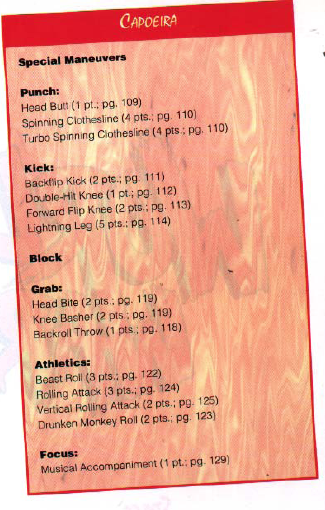
Blanka : Blanka only came onto the Street Fighting scene a few years ago, and shocked everyone (no pun intended) as he tore his way through the ranks. He doesn't remember his origins, and his fans have come up with many wild theories to explain his weird mutant powers. The truth is as follows: Blanka was a young boy named Jimmy, traveling to visit family in Brazil, when his plane crashed in the jungle. Jimmy was raised by a mother jaguar and the other animals of the jungle. He adopted the name "Blanka" in imitation of the sound of the jaguar's coughing snarl.
Jimmy learned a predator's instincts from the jaguars, and acrobatics from playing with monkeys. However, he also caught a bizarre monkey virus that caused a genetic mutation, which is how he acquired claws, fangs, green skin, and a mane of orange hair. It also gave him superhuman strength and the ability to enhance his body's natural electric field, which he learned to control by swimming with electric eels.
Blanka rejoined human society by way of a slave who escaped from a Shadoloo drug plantation. Blanka protected him and taught him how to survive in the jungle; in return, the man taught Blanka Capoeira.
The trauma of the plane crash and the fever brought on by the virus has mostly erased Blanka's memory of his origins. The Capoeira master returned to his family and encouraged Blanka to discover his own origins. Blanka became the protector of a fishing village, and demolished an entire stable of Street Fighters who showed up to make trouble. Since then, he's became a World Warrior while searching for the truth of his past.
Blanka, like all the World Warriors, is a badass. 5/5/5 in his Physical Attributes, 5 in all Techniques (except Focus 4 and Athletics 6!), and several combos, though he doesn't have a huge arsenal of Maneuvers.
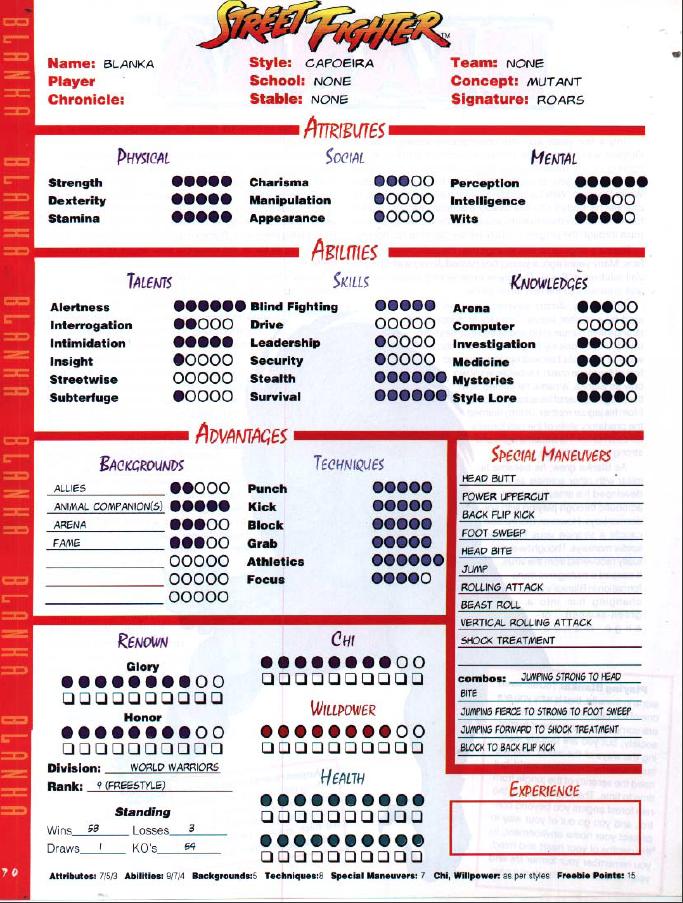
Kabaddi : The story of Kabaddi is basically an Indian version of the legends of Shaolin kung fu. Monks who dedicated their lives to meditation and yoga learned how to levitate, walk through walls, and kick people from ten feet away. Of course, they never used their abilities for violence, except when they needed to defend themselves from brigands and invaders. Moreso than physical conditioning, Kabaddi requires extreme self-discipline and diamond focus. On a physical, tactical level, Kabaddi fighters win by calmly anticipating their opponent's attacks, using hit-and-run methods while the enemy gets frustrated and loses control.
Kabaddi schools are scattered around the world, but they usually only admit a select few students--it takes a certain kind of person to even begin to learn Kabaddi.
Rules-wise, Kabaddi gets a lot of Focus Maneuvers, but is really light on more mundane fighting techniques. Playing a successful Kabaddi fighter probably requires learning "Any" Maneuvers until you have the Focus to completely change your game by adding projectiles and Extendible Limbs.
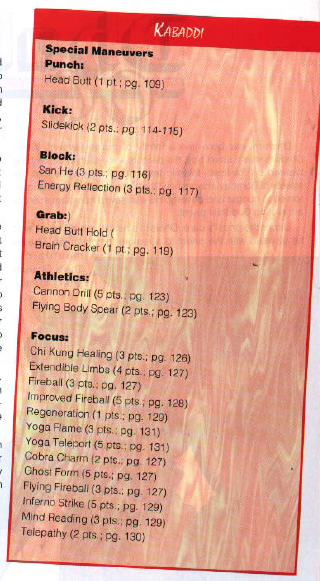
Dhalsim : Dhalsim was born to a simple farming family, and orphaned when his parents were killed in a bombing committed by Pakistani terrorists. He remained a starving orphan on the streets of Bombay before a Buddhist priest took him in and nursed him back to health. Dhalsim was raised in a Tibetan Buddhist temple, where he learned yoga and Buddhist philosophy. When he reached adulthood, he left the temple to travel around India until, in Calcutta, he found a secret Buddhist brotherhood that still practiced Kabaddi. Although he is generally a pacifist, Dhalsim found that Kabaddi training was excellent for his meditative practice, so he continued training with the monks. He eventually reached the point where the only way to learn anything knew was by testing his skills against great fighters, so he entered the Street Fighter circuit. Although he uses his earnings to support a Buddhist temple in New Delhi, Dhalsim is not actually a monk; he has a wife and child.
Dhalsim is kind of an offbeat World Warrior, as suits his style. His Physical Attributes are "only" 4/3/5, but his Mentals are 5/6/6, the better to fry you with his Yoga Flame.
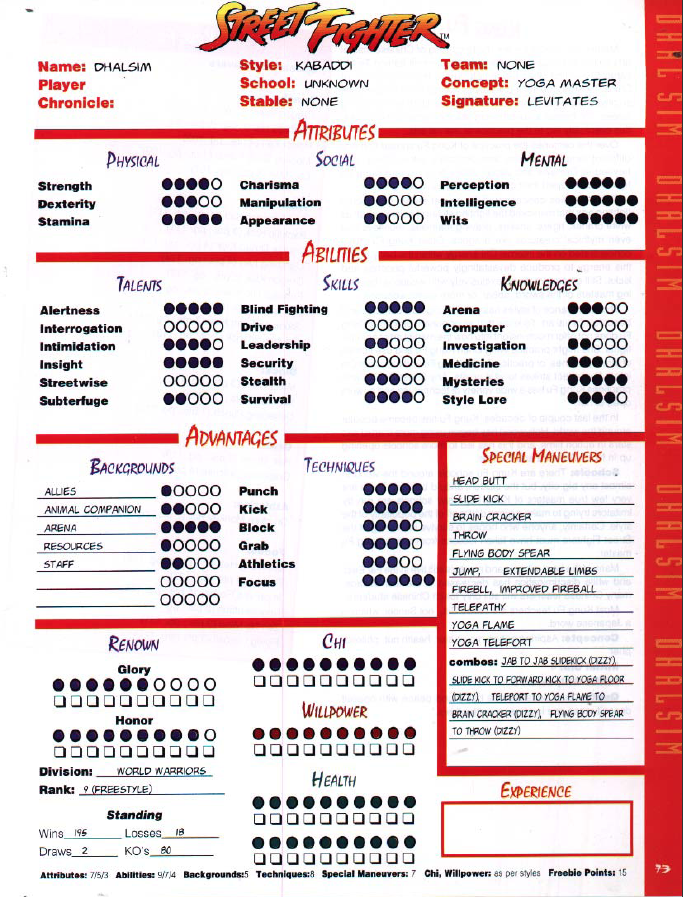
Kung Fu : Kung fu is said to have begun when an Indian monk came to the first Shao-Lin temple. He found that the monks were so physically unfit that they fell asleep during meditation; the conditioning regimen he founded eventually became kung fu. There are many different substyles of kung fu, some imitating animals, some focusing on developing internal energy. Kung Fu encompasses a broad variety of regional styles, which makes kung fu fighters difficult to predict. There are kung fu schools all over the world, but the really great instructors are few and far between.
Kung fu is a fucking great style--it has a ton of Maneuvers, and Kung Fu fighters can learn a lot of high-level Maneuvers from other styles like Shotokan and Wu Shu.
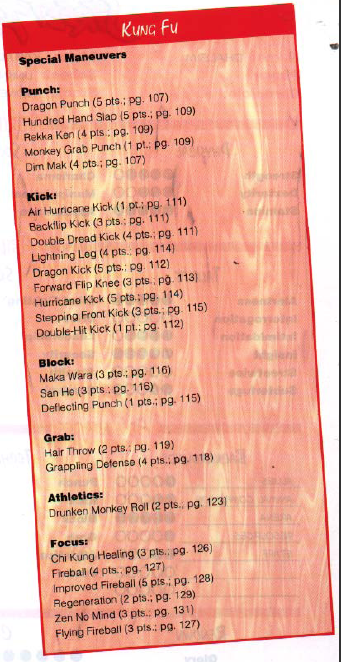
Fei Long : Fei Long is a fanboy who made good. He grew up a kung fu movie fanatic, and began practicing kung fu in secret with a master who gave him a part-time job so his disapproving father wouldn't know he was learning how to fight. Fei Long became a master of Wing Chun, but when his master died, he plateaued until he traveled to mainland China to study with Shaolin monks and learning their animal-style kung fu. Eventually, he got tired of the discipline of temple life, and returned to Hong Kong where he became an action-movie star. However, he became frustrated with the greed and politics of the film industry, and returned to tournament fighting. Eventually he reached a point where only Street Fighter tournaments could challenge his skills. Fei Long is a newly-minted World Warrior, and is eager to face off against the established elite.
Fei Long is pretty well-rounded, very fast and with a lot of Dizzy combos.
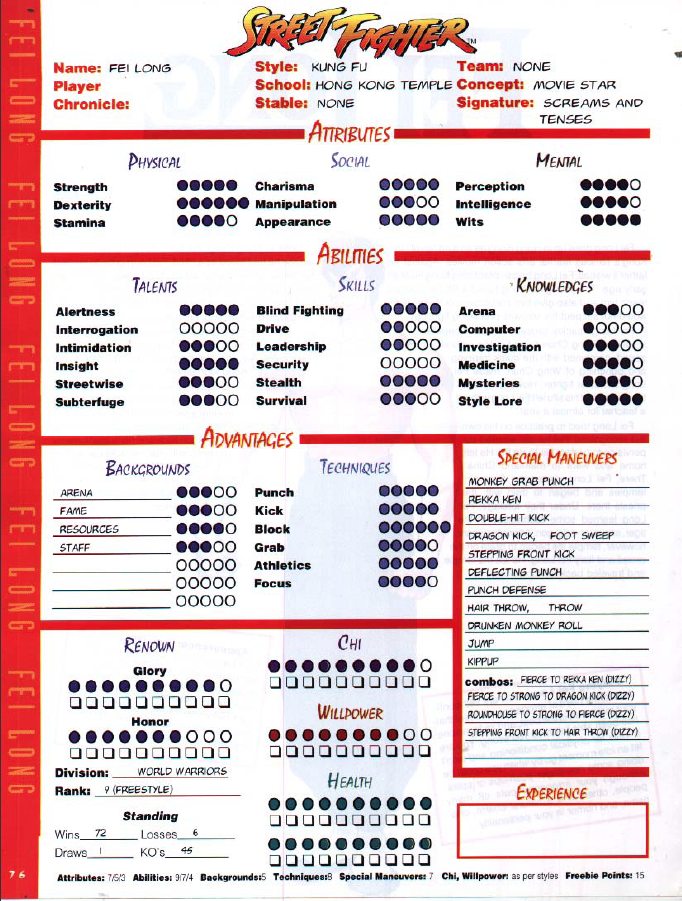
Native American Wrestling : This wrestling style began as a way for braves to test and develop their strength and speed. T. Hawk revolutionized the style and brought it into the limelight when he combined the practice with traditional mysticism and teachings about mental and spiritual strength. As a consequence, the style is on the rise in the Street Fighter circuit.
Native American wrestling requires quick-thinking and adaptability. It relies on clever counterattacks and setting an opponent up so that they don't realize they've made a mistake until they've been slammed. Wrestlers are good at reading an opponent's weaknesses and being prepared for any attack with a variety of counters and combinations. The style's only real weakness is that some overconfident young fighters never embrace the higher mysteries--they learn a few quick tricks, then start their fighting career without being prepared to achieve greatness.
Apparently, the style has become popular enough that it's easy to find schools, but the ones that teach the advanced moves are almost all on reservations, and often only teach those of native descent. However, the style has a diverse membership, and trainers can bring out the best in any student if they're prepared to learn quickly and continually.
(As an aside, I find all of this hilarious, as T. Hawk's "fighting style" is quite clearly "be freakishly huge and strong.")
Rules-wise, it's a pretty good style for the type of fighter it's meant to support--hard hits, crushing grabs. It has some specialty Punches, and a grappling portfolio to rival Sanbo.
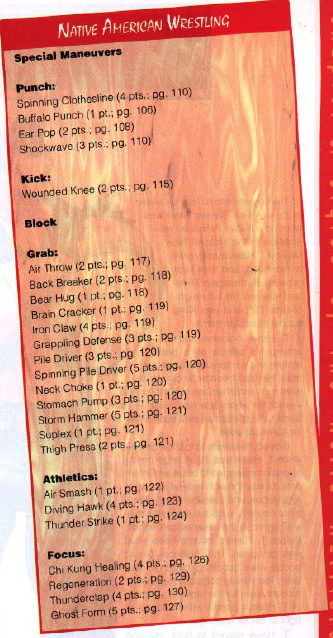
T. Hawk : T. Hawk (the T stands for "Thunder") was born on a New Mexico reservation and grew up fast, both literally and figuratively. By the age of 18 he was 7'2" and was packing on muscle. The next year, a mining operation used bribery and intimidation to take control of the reservation's lands. Rather than be virtual slave laborers in a company-run shantytown, most of his people emigrated to Mexico. T. Hawk and his allies remained behind to sabotage the mining operation--which, it turned out, was a Shadoloo front. Hawk and his friends were soundly beaten by a stable of Shadoloo-backed Street Fighters and unceremoniously dumped in Mexico. Vowing revenge, T. Hawk embraced his tribe's mystical traditions and perfected the art of Native American Wrestling. He embarked on a vision quest, and was visited by a hawk spirit who showed him the secret of what would become his most potent Special Maneuvers. Years later, T. Hawk entered the underground Street Fighter tournaments and crushed everything in his path. He's since advanced to World Warrior status, and hopes to somehow use his position as a Street Fighter to get a shot at M. Bison and reclaim his tribal lands.
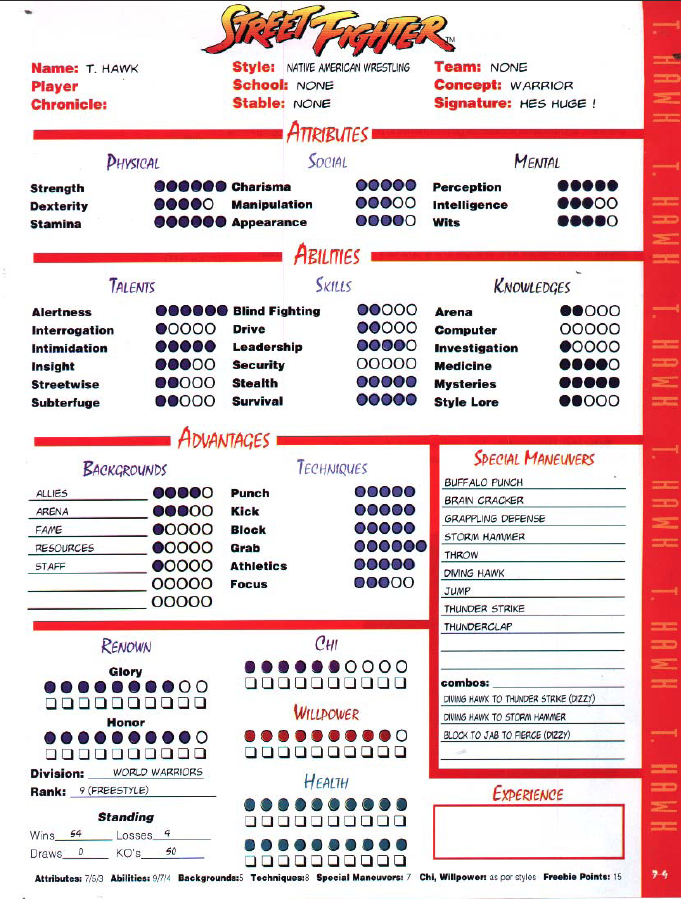
Sanbo : Sanbo is a traditional Russian wrestling style which remained part of Russian culture even in the era of the USSR. Its students believe that Sanbo proves who has the greatest strength and will. Sanbo relies almost entirely on size and strength, and students will perform all kinds of stunts to become the biggest and strongest--wrestling bears, dragging heavy loads through the snow, so on. Sanbo doesn't care about technique or speed, just crushing strikes and stunning throws. Zangief's success has increased international interest in Sanbo.
There are few Sanbo schools, mostly in Russia. There's not much to the Sanbo curriculum--you learn the basics, and then you sink or swim in practice.
As a style, Sanbo has lots of Grab techniques and little else. If you choose Sanbo, it's because you want to play a grappler with a few hard-hitting Punch Maneuvers, end of story.
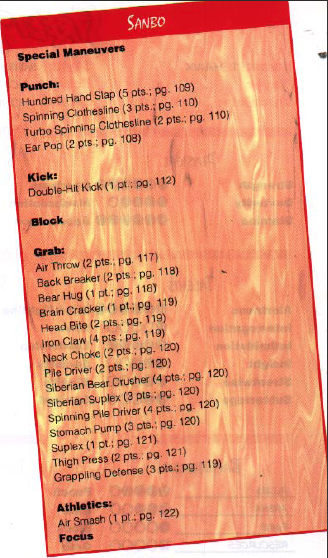
Zangief : Zangief grew up a Russian nationalist and a strong believer in Communism. He worked as a manual laborer in an oil refinery, where he caught the eye of a politician who saw his potential as an athlete. Zangief was glad to represent his country in sports, and began learning Sanbo, which he found entertaining. However, after he crippled an opponent, he vowed to give up normal wrestling. He trained by taking government-sponsored trips to Siberia to wrestle bears, where he acquired his famous scars. Eventually, even bears were not strong enough to challenge him, and the Russian government sponsored his entry into a Street Fighter tournament. He's been a fighter ever since. Although the Soviet Union collapsed, that only reinforced his desire to be a symbol of strength to encourage his countrymen. Zangief fights to prove the greatness of Russia.
Tips for beating Zangief: Don't let him grab you. Do not. Let him. Grab you.
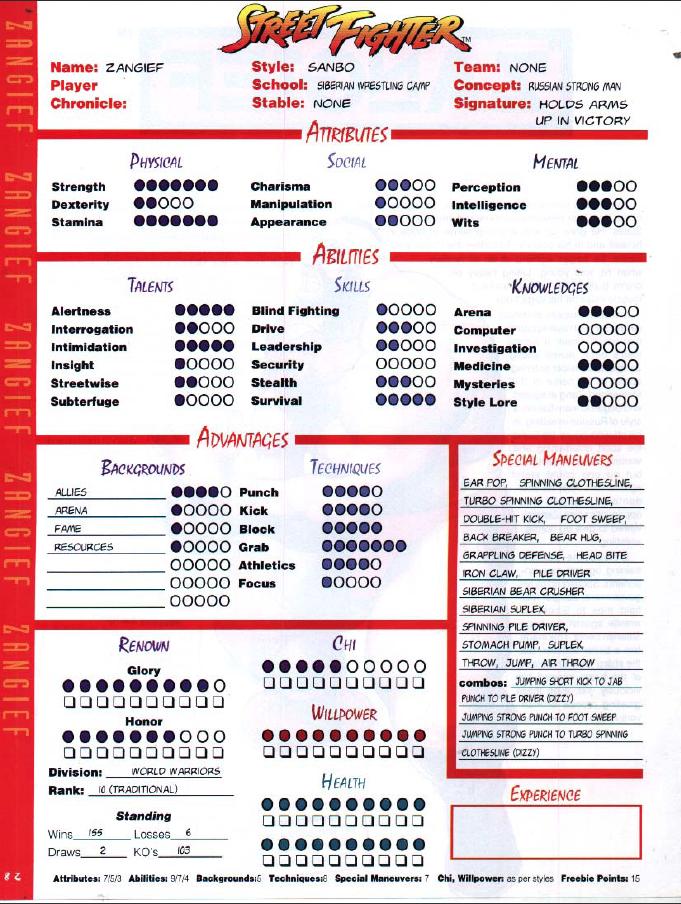
Next time, on Street Fighter : Styles, part the second. Shotokan Karate, Special Forces Training, Sumo, Wu Shu, and Western Kickboxing.
More Fighting Styles of the World Warriors
Original SA post
Street Fighter, Chapter 6, Part 2: The Fighting Styles of the World Warriors
I'd like to mention, as an aside, that there are three types of art in this chapter: Art by Jeff Rebner, art by Bengus that Capcom provided, and garbage. I mean, compare this
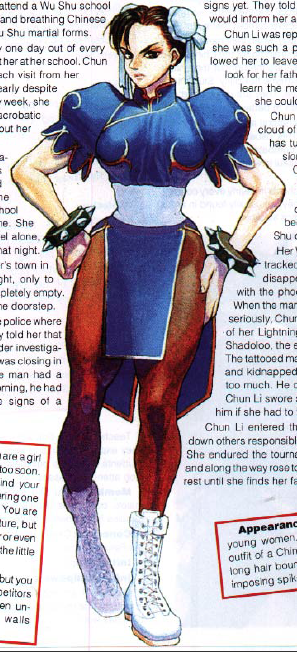
and this
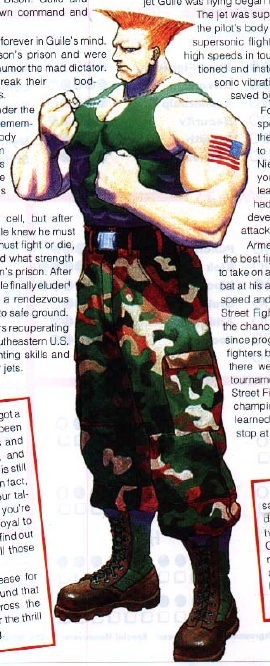
to this
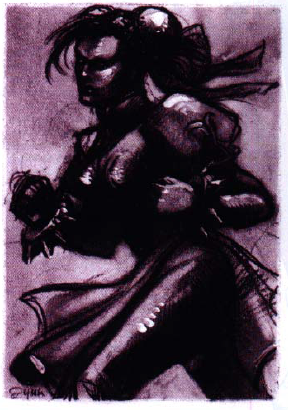
and this
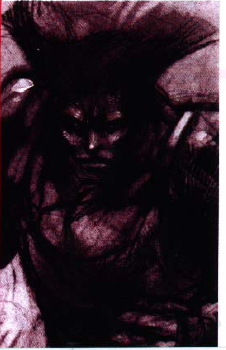
Shotokan Karate : Shotokan Karate was created by an order Chinese monks 2000 years ago, and passed down from one generation of champions to another until the modern day. Shotokan is like a superior form of Karate; its students are usually handpicked from those who have excelled in Karate. Shotokan goes above and beyond standard Karate with power derived from the fighter's internal energy. Its students are known for having a strong sense of honor, self-discipline, and habit of pushing themselves to the limits. They only care about self-improvement and the purity of the fight itself, not for earning wealth or fame by fighting.
Ryu made Shotokan the most famous Street Fighting style when he took the championship from Sagat. Shotokan schools are easy to find, but true masters are not. Training is straightforward; students start by pinning down the basics of karate technique and then advance to more complex maneuvers. Mastering the Dragon Punch is considered the mark of a true Shotokan fighter.
As a style, Shotokan doesn't have a huge catalogue of maneuvers, but it does have plenty of quality advanced maneuvers. Still, if you pick this style, you're probably going to end up with basically the same moveset as Ken and Ryu.
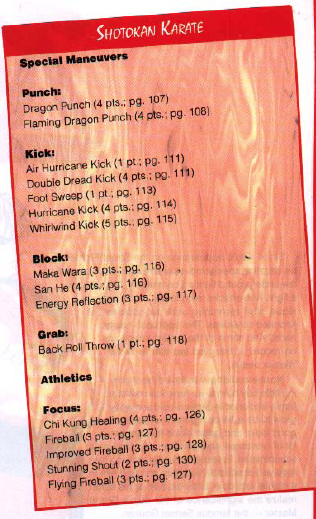
Ken : Ken is one of the most famous and popular World Warriors, known for his relentless attacks and record knockouts. Ken grew up an Army brat to a father stationed in Japan, and being a delicate-looking blonde kid got him picked on a lot. When his father enrolled him in a karate class, he took to it like a duck to water, and Ken was accepted for training under the great master Gouken. Ken spent years in grueling training before he finally mastered the signature maneuvers of the style. Eventually Gouken told Ken and Ryu that their training was finished, and the necessary next step was to test their art in combat. No dummy, Ken immediately returned to America to start a career in the Street Fighter ciruit. Like Ryu, Ken lives for the fight, but he has no qualms about enjoying the lifestyle of a rich and internationally famous athlete.
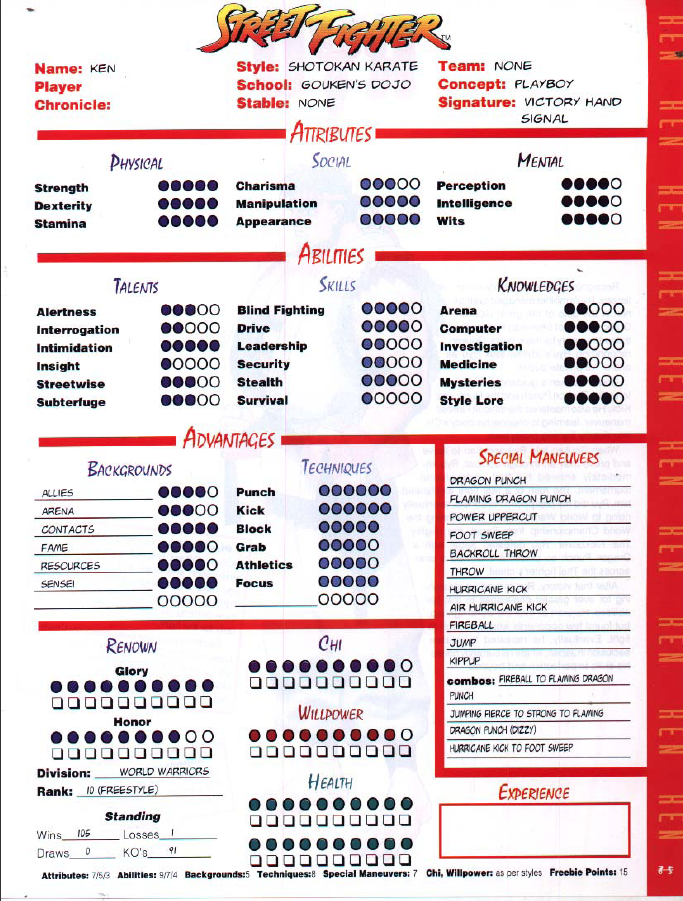
Ryu : Ryu is the son of a German businessman living in Japan. His Japanese mother taught him the basics of Karate that she had learned from her father, and Ryu quickly reached the limits of what she could teach. His mother enrolled him in Gouken's school, and he was accepted as a private student alongside Ken. Like Ken, when Gouken pronounced him a Shotokan master, he immediately entered the underground fighting scene. He quickly rose to World Warrior status, eventually taking the title of Grand Master away from Sagat. Ryu travels the world looking for an opponent who can truly challenge him; otherwise, he remains in relative seclusion in a Japanese dojo.
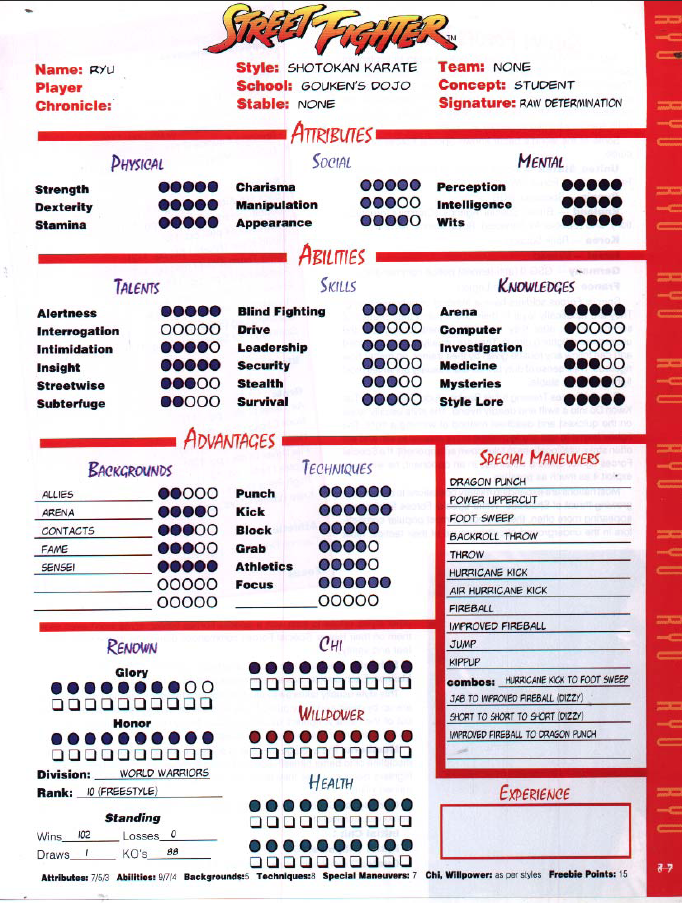
Special Forces Training : Many nations began special training programs for their elite units after WWII. Furthermore, the Cold War and the rise of terrorism created the need for military and police units specially trained to deal with it. For some, this includes advanced hand-to-hand training. Special Forces Training is a hybrid of Boxing, Judo, Jujitsu, and Tae Kwon Do. The style relies on using the fastest, most brutal way to win, and students aren't afraid to exploit an opponent's weakness or strike the most vulnerable vital points to take them down. Special Forces is a general catch-all for hand-to-hand combat of many elite military units--Green Berets, SEALs, Spetsnaz, SAS, Mossad, GSG-9, and so on. Special Forces fighters are known for nationalism, rigorous training and discipline, and doing whatever it takes to win a fight. Most fighters from other styles won't even train with Special Forces fighters.
Special Forces fighting is learned by being a member of an elite unit that trains hand-to-hand combat; that's it. Most Special Forces fighters on the Street Fighter circuit are veterans who joined the military to better themselves, but didn't have a practical use for their fighting skills after they left the service.
Special Forces Training is easily one of the best styles. You can build just about any kind of fighter you want with it, and it has plenty of access to both cheap simple Maneuvers and desirable advanced Maneuvers.
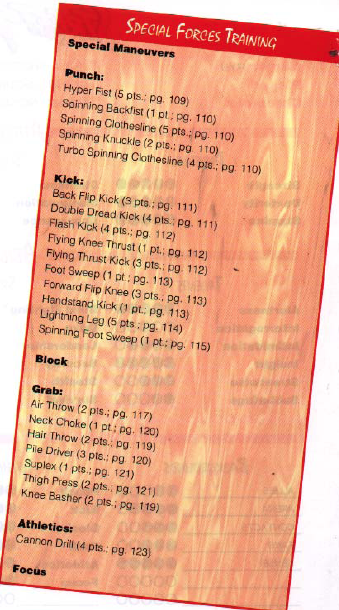
Guile : Guile joined the Army right out of high school and proved himself worthy to become a Green Beret. His story really begins when he and his comrade Charlie were sent on a secret mission to Thailand, to incite a rebellion against Bison. They were betrayed by corrupt superiors and captured. Guile and Charlie were tortured for months, sometimes just because it amused Bison to see how much they could take. When Charlie was on the verge of death, Guile watched Bison seem to siphon the last bit of life right out of him. That was when Guile decided he must escape or die, no matter the odds. He eventually escaped through the jungle and back to the United States. While recovering his health at a southern airbase, he learned how to pilot fighter jets, and was so good at it he volunteered as a test-pilot. He test-piloted an experimental supersonic jet which was supposed to use sonic vibrations to counteract the effect of G-forces on the pilot's body, but the plane malfunctioned and wracked his body with massive vibrations. Guile survived the crash, and again spent years getting his health back. However, in the process he learned how to control sonic energy. He developed his famous Flash Kick and Sonic Boom. When he learned of underground Street Fighter competitions, he jumped at the chance and tore his way to World Warrior rank. Guile knows that Shadoloo has its tentacles wrapped around the international fighting circuit, and he'll stop at nothing to get revenge on Bison.
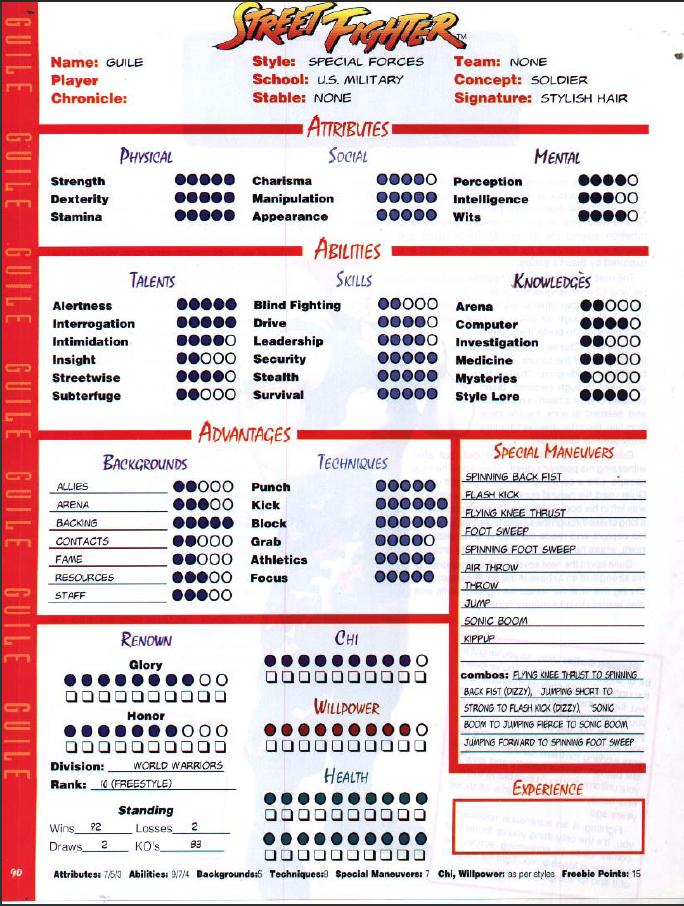
Cammy : Cammy's past is a mystery. She showed up on the Street Fighter circuit as a pretty 19-year-old girl and flattened foe after foe until she became the newest and youngest World Warrior. Her good looks, accent, and bad attitude make her a fan favourite. What her fans don't know is that she's a secret agent for the British government. She was dropped off at a British Special Agency facility at the age of 18 with no memory of her past, and somehow became a top field agent. The British government decided to use her to infiltrate Shadoloo through the Street Fighter tournaments. She's happy to do it, sensing that Shadoloo has something to do with her past, and that the more she learns about the organization, the more she'll uncover about her past.
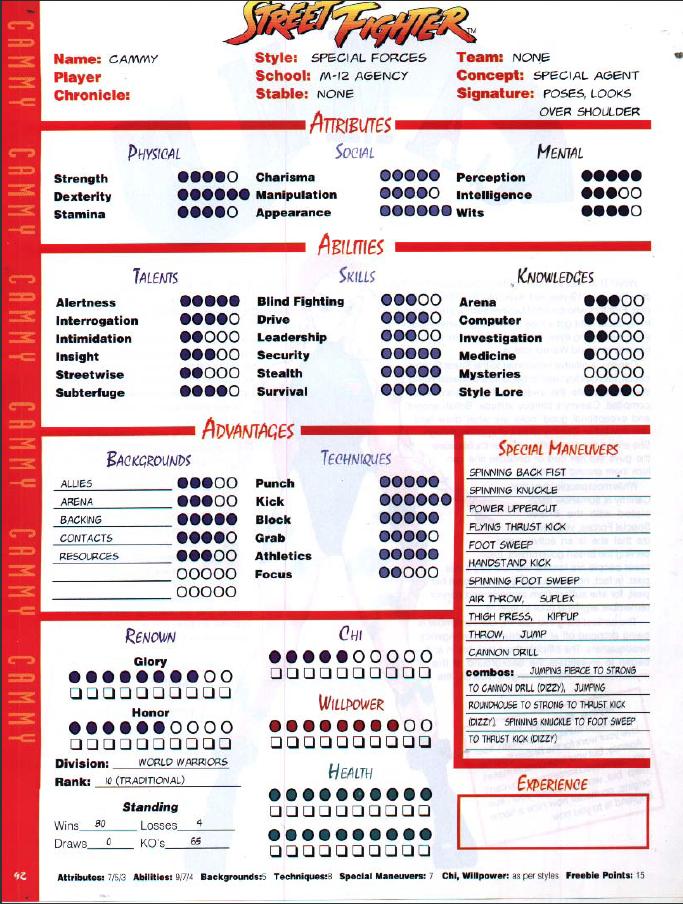
Sumo Wrestling : Sumo is an art as old as Japan itself. Great sumotori are revered like gods in Japan. Being a great sumo wrestler takes great size, strength, and dedication, and sumotori have a great deal of pride in their art and respect for their opponents. Sumo technique incorporates punches, kicks, and blocks, as well as flying tackles, all with the goal of flattening the opponent. The art of Sumo is earning respect from around the world, as indicated by the fact that the greatest yokozuna was American, before E. Honda beat him. More and more Sumo wrestlers have joined Street Fighter competitions to prove their art against others.
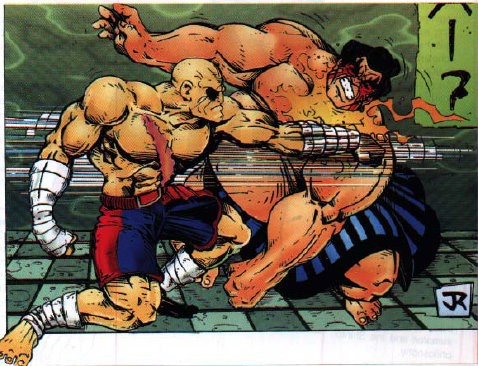
This is sumo's signature image. Is that supposed to inspire confidence?
Sumo is taught worldwide, but the best schools are still in Japan. Sumotori are ranked by size and accomplishment, and sumo training involves many grueling tests of strength, endurance, and will. Sumo is a highly traditional art, and its membership is exclusively big, strong men.
Sumo is frankly a crap style, rules-wise. It has very few Maneuvers overall, and its only capstone is the Hundred Hand Slap.

E. Honda : Edmond Honda was raised in Osaka and joined a sumo academy at a young age. Honda was dedicated to his training, but because he was a late bloomer, he often lost to larger boys. He trained harder. As he got older, he applied his focus to traditional Japanese poetry and studying Shinto philosophy. He also began to win more and more matches as his training regimen finally paid off. He applied his scholarship to the history of the Sumo style, mastering the finer points of all its techniques. Eventually he earned the rank of yokozuna and proved himself worthy of it by winning several tournaments in a row. Satisfied with his accomplishments in the sport, he began writing and teaching sumo. When other martial artists interpreted his comments as boasts of superiority, he felt obligated to accept their challenges on behalf of Sumo itself. Honda defeated all challengers and modified Sumo for full-contact fighting in the Street Fighter tournaments. He's been a respected World Warrior for years now.
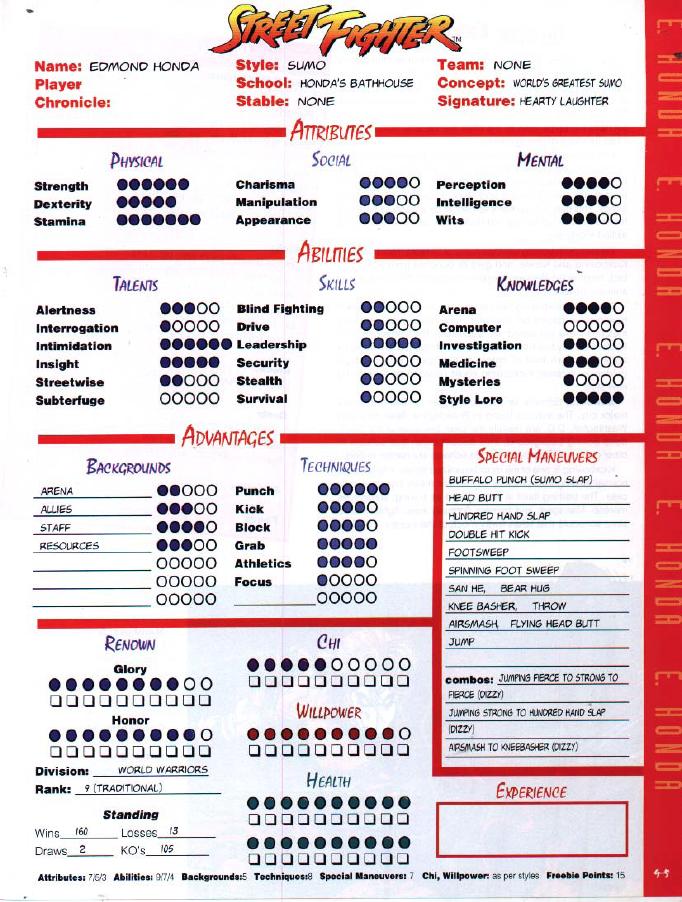
Western Kickboxing : Western Kickboxing began when martial artists in the Western world began staging full-contact competitions. Western Kickboxing is a sort of organic hybrid of Boxing, Karate, Kung Fu, Tae Kwon Do, and Muay Thai. Although kickboxing tournaments didn't maintain mainstream popularity, people kept practicing it. Western Kickboxing blends the showmanship of boxing with the discipline of the martial arts. It adds spins and leaps to traditional martial arts techniques. Most good Western kickboxers begin as amateur boxers. Western Kickboxing has become popular again thanks to its success on the Street Fighter scene, and from being featured in movies. It's still a relatively new style in Street Fighting.
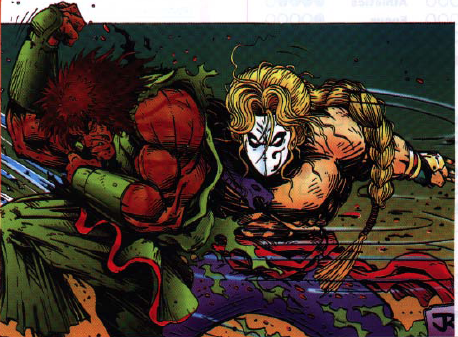
See Sumo, above.
Schools for kickboxing are easy to find; the best are in cities with a history of good boxers. The training is tough and the curricula well-organized.
Western Kickboxing is a pretty good, well, kickboxing style with a variety of beginning and advanced Punch and Kick Maneuvers.
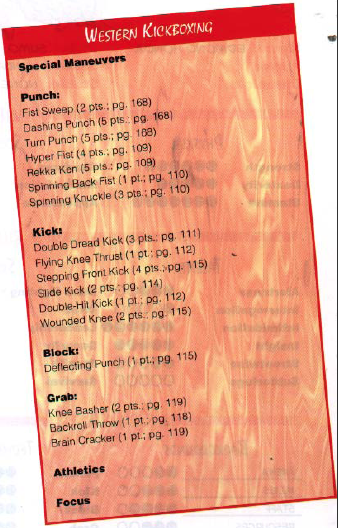
Dee Jay : Dee Jay does not have the most orthodox history for a World Warrior. He began as a reggae singer performing throughout the Caribbean, and became a fan of kickboxing before he decided to try it himself. It only took him five years of training to become ready for professional competition. He acquired a reputation for skill and showmanship, and was invited to join a Street Fighter tournament. At first he declined, but attended the tournament as a spectator, and was so impressed he decided to join after all. While he was trying to develop some truly over-the-top moves in preparation for the fights, he continued his singing career, and unleashed latent sonic powers during a concert, blowing out a speaker. He learned to harness that power, and developed a Sonic Boom of his own (which he calls the "Max Out") along with his devastating uppercuts and spinning kicks. Dee Jay thinks of himself as both a fighter and an entertainer, and has developed a devoted fan following who travel around the world to see him fight.
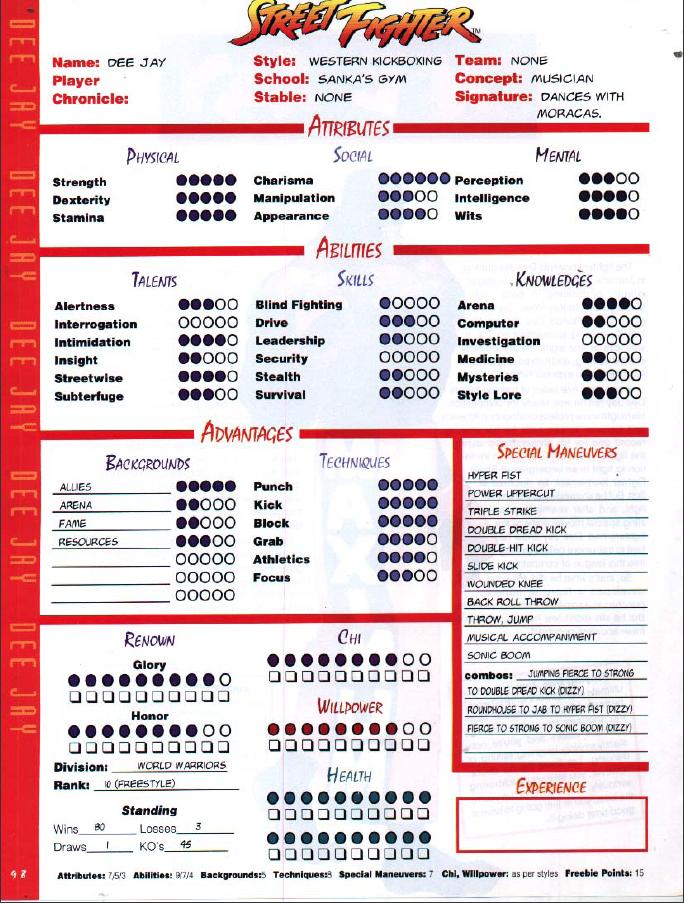
Wu Shu : Wu Shu originated as a more peaceful way of practicing kung fu in China. The Communist government outlawed traditional Kung Fu and replaced it with state-sponsored Wu Shu. The government didn't want anyone practicing fighting arts without their approval, so they created Wu Shu to preserve the cultural aspects of Kung Fu while shifting the emphasis from fighting to acrobatic performance art. It's been criticized as too flashy and not a real combat style, but there are enough talented Wu Shu fighters on the Street Fighter circuit to earn it a newfound measure of respect. Wu Shu methods combine kung fu technique with acrobatics, and rely on speed, grace, and accuracy.
Wu Shu students are usually enrolled as young children with the hopes of one day competing in national Wu Shu competitions. Students continue their training throughout childhood, learning endurance and gymnastic agility. The best Wu Shu schools are in China, and usually in places that also have good gymnastics schools. Because of the link between Wu Shu and gymnastics, women are the majority of Wu Shu students. Although schools are relatively easy to find, the training is very hard, and students are expected to pull their own weight or drop out.
Wu Shu is a top-shelf style. It's light on punching and grappling, but has a ridiculous arsenal of kicking and aerial techniques.
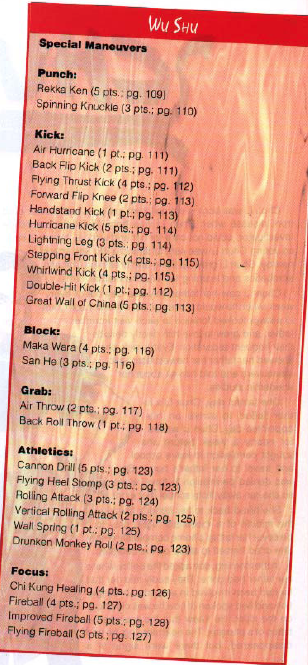
Chun Li : Chun Li lost her mother soon after birth, and spent most of her time at a Wu Shu academy while her father attended his duties as a police detective. She lived for Wu Shu practice and to show her father what she'd learned whenever he came to visit. When he didn't show up for an expected visit, Chun Li left the academy to find out what happened to him, but found his home empty. She found out that her father had disappeared while investigating a murder case. Chun Li continued studying Wu Shu, but arranged to be able to take breaks from school to search for her father. She has not yet found her father, but has become a skilled private investigator and won the national Wu Shu championships. When she finally tracked down her father's kidnapper, she learned that he'd been handed over to Shadoloo. Chun Li is an Interpol agent, and has ties to the Chinese government. She's vowed to use her connections in both law enforcement and the world of Street Fighting to find out what happened to her father, even if she has to beat the truth out of M. Bison himself.
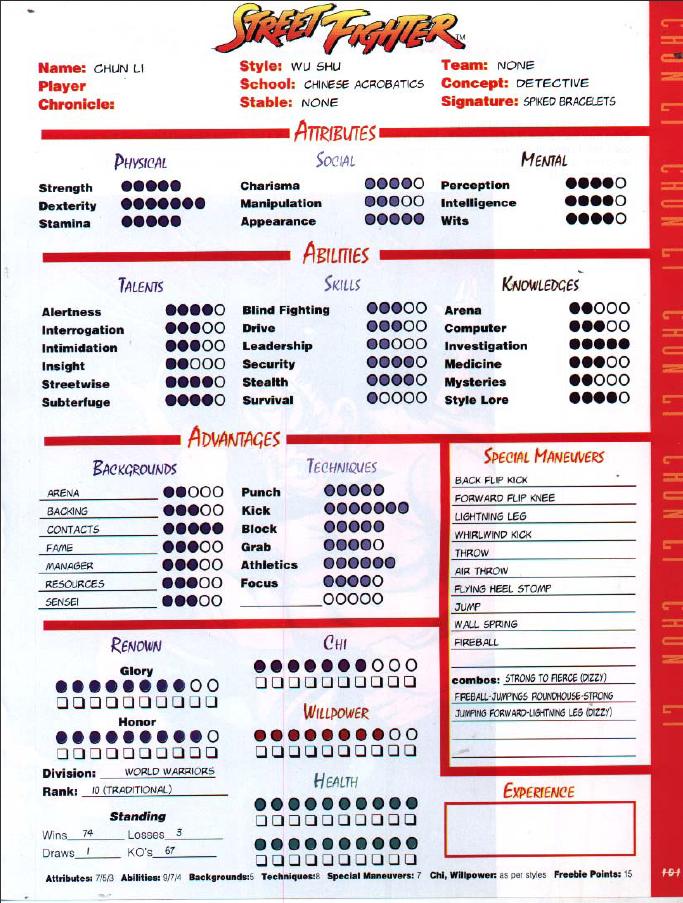
Next time, on Street Fighter : Special Maneuvers, or, What All That Crap Meant, Basically.
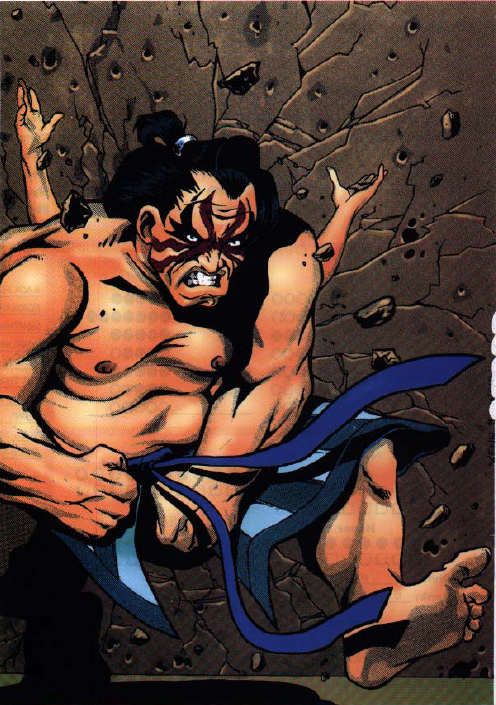
This isn't a bird's eye view; that's a wall behind him. What are we looking at here? Did he beat his opponent by backing up on him really fast? Did he lift his leg and slam him into the wall with a Sumo Death Fart?
Special Maneuvers, or, Now I Show You Some Trick or Two
Original SA post
Oh, I'll just put it here.

Street Fighter, Chapter 7: Special Maneuvers, or, Now I Show You Some Trick or Two
Anyone, says the book, can learn the basics of a martial art, but only dedicated athletes have the skill and discipline to develop Special Maneuvers. Street Fighters are often distinguished because of their special moves. There are a few Basic Maneuvers anyone can do in combat: Move, Block, Grab, or Jab/Strong/Fierce Punch or Kick.
Everything else
is a special maneuver, so Special Maneuvers cover things like "sliding kick" and "jumping punch" as well as Flash Kick, Dragon Punch, and Fireball.
Maneuvers are power. A couple great Maneuvers can easily mean the difference between victory and defeat, even against a more experienced opponent. We haven't gotten to the Combat rules section yet, but I'll tell you this: there's no to-hit roll in Street Fighter. If you have the Move to reach an opponent and they don't Block your attack or stop you from executing it (say, by using a Foot Sweep or Suplex to knock you down and deny you your action) then they're gonna get hit. Maybe your stats aren't high enough to do a lot of Damage, but if somebody has the minimum stat requirements to learn Lightning Leg, you don't wanna get touched by that shit.
(This also goes some way to explaining why Special Maneuvers are costly to learn. Why does it take so much practice and experience to learn a Double-Hit Knee? Because, once you learn it, you will
never screw it up
if you execute it at the right time.)
Every Maneuver has 3 basic components, before considering any special effects.
Speed
: In Street Fighter, everyone keeps their Maneuvers on Combat Cards and plays them simultaneously, with Speed determining Initiative order. If you can hit someone and move out of the range of the Maneuver they were planning to throw, or land a technique that scores a knockdown, you can effectively cost them their action this round. Otherwise, landing your Jab before he lands his Fierce Punch isn't worth diddly.
Damage
: The damage of your Maneuver is Strength + Technique + Maneuver bonus.
Move
: A bonus or penalty to how many hexes (yes, hexes!) you can move before attacking. (No, you can't move, hit, and finish your movement.) Some Maneuvers have a set Move, usually 1 or none.
I won't describe every Maneuver in the book, of course, but I'll be hitting the notables for each Technique.
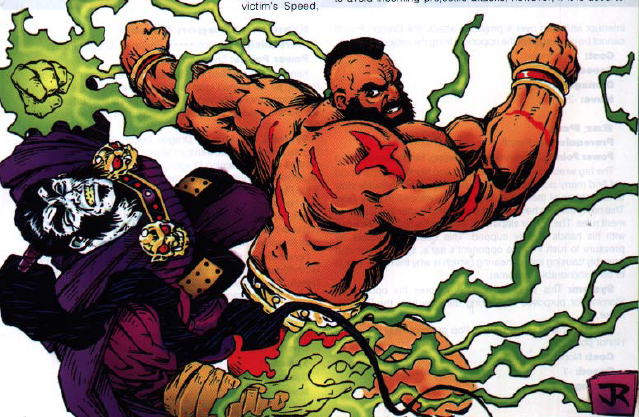
Zangief talks Mr. Sinister out his “Shogun Dracula” phase.
Punch
Dim Mak
:
+0 Speed, Damage, and Move; Costs 1 Chi. Kung Fu 5.
Yes, Master Jackson's ninja-crippling kung fu secret! By spending a Chi point, you can make a Punch attack that can do two things: One, you can delay the damage actually taking effect, and two, each time you hit with it, you temporarily reduce one of the opponent's Physical Attributes by one point. (The points can be regained after the fight, as if they were Chi.) The Storyteller is free to allow Dim Mak masters to do other strange things to their opponents at his discretion, but if I'm ST, I won't allow one PC to put all the World Warriors in wheelchairs.
Dragon Punch
:
+0 Speed, +6 Damage, -2 Move; Costs 1 Willpower. Shotokan Karate 4, Kung Fu 5.
One of the iconic moves of the franchise, the Dragon Punch is a slow but hard-hitting Aerial Maneuver. One of its prereqs is the Jump technique, and like a basic Jump, it can be used to dodge projectile attacks. It also automatically scores a Knockdown if used to interrupt another Aerial Maneuver, and anyone hit by it is knocked back a hex from the force of the blow.
Flaming Dragon Punch
:
-1 Speed, +6 Damage, -2 Move; Costs 1 Chi, 1 Willpower. Shotokan Karate 4.
Ken’s refinement of the Dragon Punch. It always scores a Knockdown, and if you can get close enough to actually move into the opponent’s hex, it hits
twice
. Consider that Ken’s base damage for a Dragon Punch is 19 dice.
Hundred Hand Slap
:
Speed -2, Damage +0, Move 1. Costs 1 Willpower. Sumo 4, Kung Fu, Sambo 5
. Honda’s signature move. It’s special ability? It hits three times. So if it’s Honda, that’s 12 dice, 3 times. Ouch.
Hyper Fist
:
Speed +1, Damage +0, Move 1. Costs 1 Willpower. Western Kickboxing 4, Special Forces 5
. Hey, is that Dee Jay’s special uppercut? Yes it is. Hey, is it exactly like Hundred Hand Slap, but faster? Yes it is. But wasn’t the Hyper Fist pretty lame in Super Street Fighter 2? Yes it was.
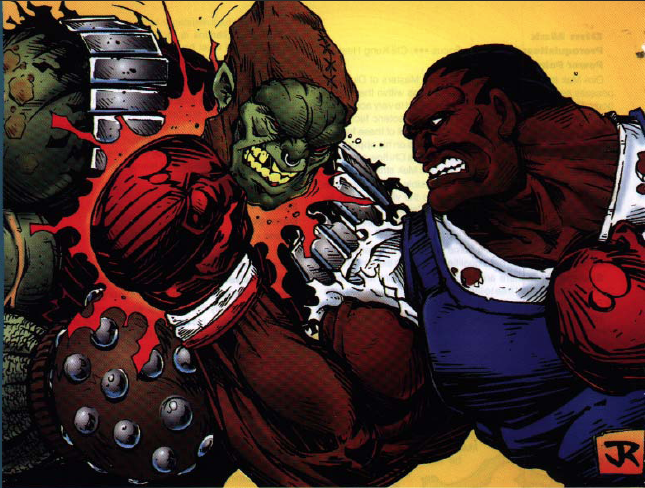
Balrog hits the orc for 6 damage.
Power Uppercut
:
Speed -1, Damage +3, Move 1
. An example of a cheap Punch move, this is a prerequisite for Hyper Fist and Dragon Punch. It scores Knockdowns when interrupting Aerial attacks, and is otherwise an unremarkable “tax” on your way to better Maneuvers.
Spinning Clothesline
:
Speed +0, Damage +0, Move -2. Costs 1 Willpower. Sanbo 3, Capoeira, Native American Wrestling 4, Special Forces 5
. Included for the Zangief marks. This is actually an interesting maneuver, because it breaks the usual rules about not moving after you attack. When you use it, you attack everyone in an adjacent hex, knocking them back, and then move another hex and do the same, until you run out of Move. It can score multiple hits on one opponent while attacking a whole group of foes, too, and is thus pretty fucking awesome.
Spinning Knuckle
:
Speed -1, Damage +1, Move +3; Costs 1 Willpower. Special Forces 2, Western Kickboxing, Wu Shu 3, Any 4
. One of Cammy’s signatures. It can be used to dodge Fireballs like a Jump, hits twice, and is remarkably cheap for 3 styles. What’s not to like?
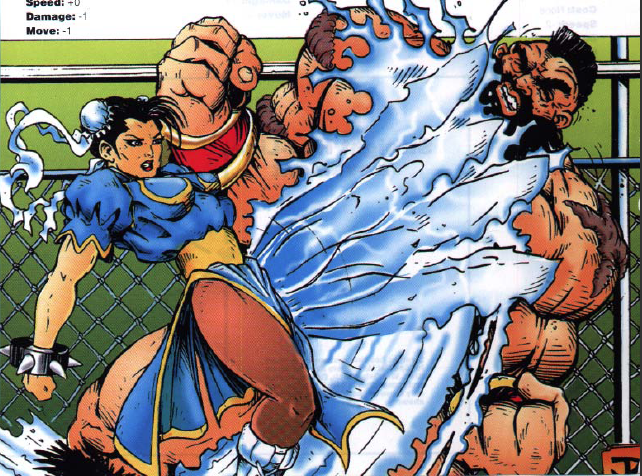
No! These leeches protect my beard from your witchcraft!
Kick
Double Dread Kick
:
Speed -2, Damage +1/+4, Move +1; Costs 1 Willpower. Western Kickboxing 3, Kung Fu, Shotokan Karate, Special Forces 4
. Dee Jay’s signature kick has interesting rules: You hit an opponent for +1 damage, knock them back 1 hex, continue moving forward (if you can) and hit them a second time for more damage, knocking them back again.
Dragon Kick
:
Speed -1, Damage +6, Move -2; Costs 1 Chi, 1 Willpower . Kung Fu 5
. Fei Long’s flaming kick. Works exactly like a Kick version of the Flaming Dragon Punch, without having to learn Dragon Punch first.
Flash Kick
:
Speed -1, Damage +7, Move None; Costs 1 Chi, 1 Willpower
. Unfortunately, Guile’s awesome kick works basically like a more expensive, slightly more damaging Dragon Punch.
Hurricane Kick
:
Speed +0, Damage -1, Move -1. Shotokan Karate 4, Kung Fu, Wu Shu 5. Costs 1 Chi, 1 Willpower.
. Works just like the Spinning Clothesline, but it’s Aerial.
Lightning Leg
:
Speed -2, Damage +1, Move None. Costs 1 Willpower. Wu Shu 3, KungFu 4, Capoeira, Special Forces 5
. Like the Hundred Hand Slap and Hyper Fist, it hits 3 times.
Slide Kick
:
Speed -1, Damage +3, Move +1. Western Kickboxing, Kabaddi 2, Any 3
. I include this as another example of a Special Maneuver that’s not a flashy signature, but has analogues in the videogames: this covers Bison and Dhalsim’s sliding sweeps. In addition to its stats, it scores a Knockdown unless the opponent blocks.
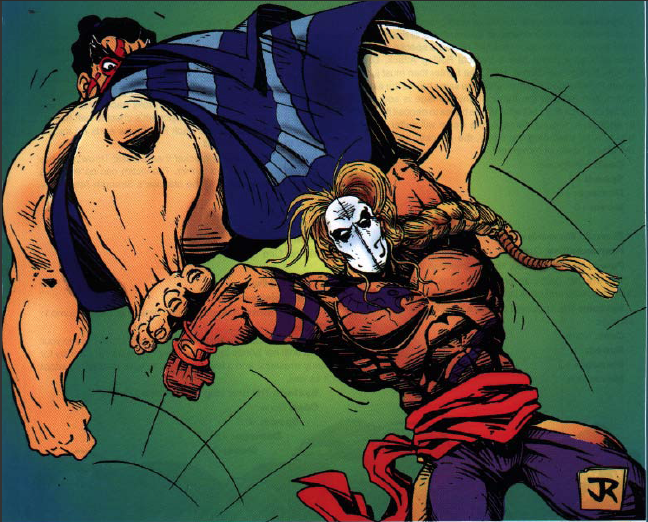
I don’t know if this is a Spanish Suplex or a Flying Sumo Crotch. They both look surprised by whatever’s happening.
Block
Block is a valuable technique by itself because it adds to your Soak rating when you use the Block Maneuver, but there are some special Block maneuvers. None of these are in the video games, so they’re good examples of the design space you can cover in a tabletop game that a realtime fighting game can’t accommodate.
Deflecting Punch
:
Speed +2, Damage +0, Move None. Kung Fu, Western Kickboxing 1, Any 2
. Slower than a standard block, and you can’t Abort to it, but you get your full Block against your opponent’s attack and then you get to punch them back!
Maka Wara
:
Kung Fu Shotokan Karate, Sumo 3, Wu Shu 4, Any 5
. Any time you Block an attack, the attacker takes your Stamina+Block-3 in damage. Not a heap, but it can add up over a match.
Missile Reflection
:
Speed +3, Damage None , Move -1. Any 2.
If you’re fast enough to interrupt your opponent’s projectile attack (and were lucky enough to guess that that’s what they were going to do), you can make a Dexterity roll (Difficulty 6) to harmlessly deflect it—or even reflect it back at the shooter, or at someone else. Thrown weapons require 1 success, missile weapons like bows require 2, gunfire takes 3 successes. You can deflect/reflect
any
number of projectiles in the turn you use the maneuver.
Energy Reflection
:
Speed +1, Damage 0, Move 0. Costs 1 Chi. Kabaddi, Shotokan 3, Any 4
. You need this to deflect Fireballs and Sonic Booms.
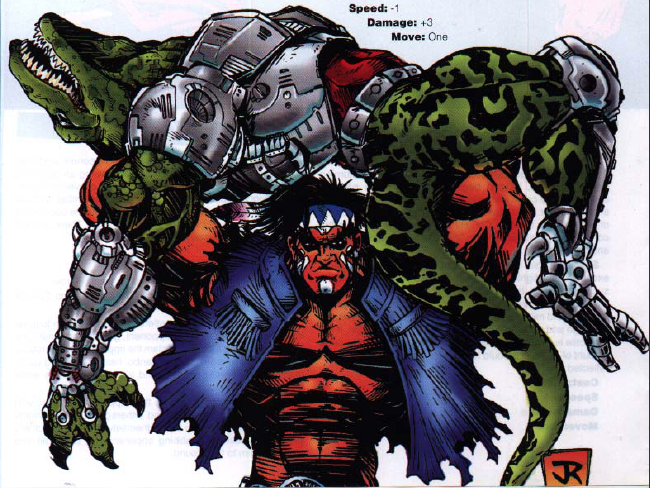
T. Hawk scores a flawless victory on the coolest thing your seven-year-old mind could think of.
Grab
Brain Cracker
:
Speed +0, Damage +2, Move 1. Kabaddi, Native American Wrestling, Western Kickboxing 1, Any 2
. This is the Dhalsim move that my friends and I all called the “Yoga Noogie.” It’s a Sustained Hold, meaning that you can just maintain it from turn to turn, automatically damaging the opponent until they break free.
Head Bite
:
Speed +1, Damage +3, Move 1. Capoeira, Sanbo 2, Any 3
. Like the Brain Cracker, but better. Yes, it’s Blanka’s chow-down move.
Siberian Bear Crusher
:
Speed +0, Damage +3, Move +1. Costs 1 Willpower. Sanbo 5
. Zangief’s tackling powerbomb. It’s easy to see why it’s expensive and Sanbo only—unlike most Grab maneuvers, it doesn’t restrict you to a Move of 1, so the move isn’t ruined if a fast opponent interrupts you as soon as you move into his hex.
Siberian Suplex
:
Speed +0, Damage +2, Move 1. Costs 1 Willpower. Sanbo 3
. A Suplex that hits twice.
Spinning Pile Driver
:
Speed -2, Damage +7, Move 1. Costs 2 Willpower. Sanbo 4, Native American Wrestling 5
. A Pile Driver that can dodge fireballs like Jump, scores a Knockdown, and bounces the opponent on their head so hard that they fly 3 hexes away from you.
Storm Hammer
:
Speed -2, Damage +7, Move 1. Costs 2 Willpower. Native American Wrestling 5
. T. Hawk summons the power of the eagle spirits to—oh come on, he grabs a guy and jumps and slams his face in the ground. Very much like the Spinning Pile Driver, except that the attacker and opponent both move 3 hexes in the attacker’s direction, due to the leaping smash.
Suplex
:
Speed +0, Damage +2, Move 1. Native American Wrestling, Sanbo, Special Forces 1, Any 2
. A faster improvement over a basic Grab (or the Throw technique anyone can buy for 1 point). Scores a Knockdown.
Thigh Press
:
Speed -1, Damage +4, Move 1. N.A. Wrestling, Sanbo, Special Forces 2, Any 3
. If you’re a Street Fighter fan, this is Cammy’s Thigh Press. If you’re a Mortal Kombat fan, it’s Sonya’s Leg Grab. If you’re a pro wrestling fan, it’s a Frankensteiner.
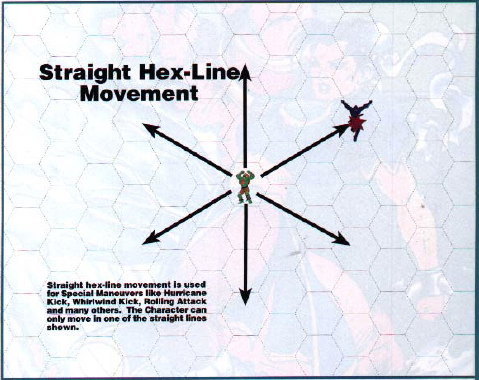
Blanka is doing this PSA as part of his parole agreement. The ninja is Lou Gossett, Jr.
Athletics
Athletics is important by itself because it’s the base Move of
all
your Maneuvers. That being said, there are some cool Athletics attacks.
Air Smash
:
Speed -1, Damage +4, Move -1. NA Wrestling, Sanbo, Sumo 1, Any 2
. Another vidja game maneuver, this represents Honda’s Flying Diaper Attack and Zangief and Hawk’s Flying Chest Thump.
Beast Roll
:
Speed +0, Damage +3, Move -2/+2. Costs 1 Willpower. Capoeira 3
. One of Blanka’s signatures, a curious move that requires a graphic to explain how it works. First you move backward, then you flip forward. It can thus potentially hit two opponents, and it can dodge Fireballs.
Cannon Drill
:
Speed +2, Damage +2, Move +2. Costs 1 Willpower. Special Forces 4, Kabaddi, Wu Shu 5
. Fast, potent, great range, and doesn’t count as Aerial because it flies low. I just want to note that thanks to Cammy, “Special Forces” commandoes get a price break on flying kicks and hurracanranas.
Diving Hawk
:
Speed +0, Damage +5, Move +2. Costs 1 Willpower. NA Wrestling 4
. “The ultimate cure for Fireball blues.” The other maneuvers that allow you to dodge projectiles don’t let you use the attack against the shooter—this one does. First you dodge the fireball, then you hit the laser karate bitch with a flying tackle, then you get the women.
Jump
:
Speed +3, Damage 0, Move +0. Any 1
. A Jump can be played by itself to turn a normal Move into an Aerial Maneuver, or with a Basic Maneuver punch or kick to make one of those moves an Aerial Maneuver. In either case, it allows you to dodge projectiles if your Speed is higher than the shooter’s, and if you can beat their Focus with your Dexterity+Athletics in a resisted roll. These same rules apply to the Flash Kick, Dragon Punch, and all other Aerial maneuvers that allow projectile-dodging.
Rolling Attack
:
Speed +0, Damage +3, Move +4. Costs 1 Willpower. Capoeira, Wu Shu 3, Any 5
. A rangy, hard-hitting Aerial Maneuver, though it can’t dodge projectiles. The flavor text suggests using this to smash through the window of a getaway car, which is badass.
Thunderstrike
:
Speed +0, Damage +5, Move -1. Native American Wrestling 1
. As a sop for not being a very good style, T. Hawk wannabes get this brokenly good attack that is cheap, costs no disposables, and can dodge fireballs.
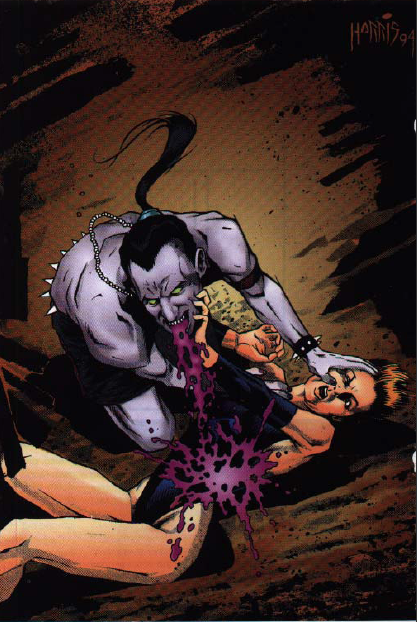
Raise your hand if you want the hot wax.
Focus
Acid Breath
:
Speed -2, Damage +3/0/-3, Move -1. Costs 1 Chi. Any 4
. Did I mention that this game occasionally includes moves that are obviously designed to let you play Mortal Kombat? This is one of them. You vomit Chi-infused stomach acid at your opponent, which does +3 Damage on the first turn and continues burning their flesh for two more turns at reduced damage.
Chi Kung Healing
:
Speed -1, Damage None, Move -1. Kabaddi, Kung Fu 3, NA Wrestling, Shotokan, Wu Shu 4
. This move allows you to spend Chi to restore Health to someone else. Which, unless you’re a Focus-intensive character who somehow has a fat pool of Chi you don’t intend to use, is probably a bad idea within combat. But hey, it’s a prerequisite for Dim Mak.
Extendible Limbs
:
Kabaddi 4
. You combine this Maneuver with a Basic punch or kick, which gives it a range equal to your Focus! The only disadvantage is that if a faster move interrupts you, they can damage you by striking your limbs in any hex they’re moving through.
Fireball
:
Speed -2, Damage +2, Move -2. Costs 1 Chi. Kabaddi, Shotokan 3, Kung Fu, Wu Shu 4, Any 5
. Yeah, it’s Fireball. What do you want me to say? Covers the basic Fireballs of Ken, Ryu, Chun Li, and Dhalsim. As I said in the character creation chapter, it uses Wits for Speed and Intelligence for Damage, and has a range of Wits+Focus. You need unobstructed line-of-sight to your target.
Ghost Form
:
Speed +1, Damage None, Move +0. Costs 2 Chi, 1 Chi per additional turn. Kabaddi, Native American Wrestling 5
. You can actually become insubstantial. You can’t attack, only energy attacks hurt you, and you can walk through walls or effortlessly escape from a Sustained Hold you’re in. Not extremely useful in combat, but come on, you can walk through walls.
Ice Blast
:
Speed -2, Damage +3, Move None. Costs 2 Chi. Any 4
. It’s Sub-Zero’s ice blast. It does damage, and traps the opponent helplessly in ice until they break out with a Strength roll, or until someone attacks them.
Improved Fireball
:
Speed -1, Damage +4, Move None. Costs 1 Chi. Shotokan 3, Kabaddi, Kung Fu, Wu Shu 5
. As if Ryu wasn’t already a cheap bitch, he’s mastered a fireball that’s faster, harder,
Scooter
and scores a Knockdown on non-blocking opponents.
Inferno Strike
:
Speed -2, Damage +4, Move None. Costs 2 Chi. Shotokan, Kabaddi 5
. Similar to the Improved Fireball, but the fucking thing
explodes
and hits the target and everything adjacent to it.
Repeating Fireball
:
Speed -2, Damage +0, Move None. Costs 2 Chi. Any 4
. Allows you to fire a volley of small Fireballs, up to your Focus, and you can divide them between different opponents if you like. Yes, this means you could hit someone 5 or 6 times, which is crazy. I cast Magic Missile at the Shadoloo.
Shock Treatment
:
Speed +0, Damage +7, Move None. Costs 2 Chi. Any 4
. When Blanka (or any other electricity-channeling you might happen to know) uses this move, it deals damage to everyone in his hex or an adjacent hex. Potent enough on its own, but great in group fights.
Sonic Boom
:
Speed -3, Damage +4, Move None. Costs 1 Chi. Any 4
. As with Dragon Punch, Guile gets a slower, flat-footed, slightly more damaging version of what Capcom’s precious widdle pajama-wearing baby gets. Fuck you, Ryu. You are the most boring video game protagonist since the Pong paddle.
Yoga Flame
:
Speed -2, Damage +7, Move 1. Costs 2 Chi. Kabaddi 3
. The only D&D like “cone” effect I know of in the game, it fills one adjacent hex and the three beyond it with flame. The flame lasts the whole turn, so anyone moving through that area takes damage.
Yoga Teleport
:
Speed +3, Damage None. Costs 2 Chi. Kabaddi 5
. Another Kabaddi capstone reward for playing a Focus-based character, this allows you to disappear and reappear in any hex within a range of Wits + Focus. You don’t need to make a roll to dodge projectile attacks you interrupt, and you don’t even need line-of-sight!
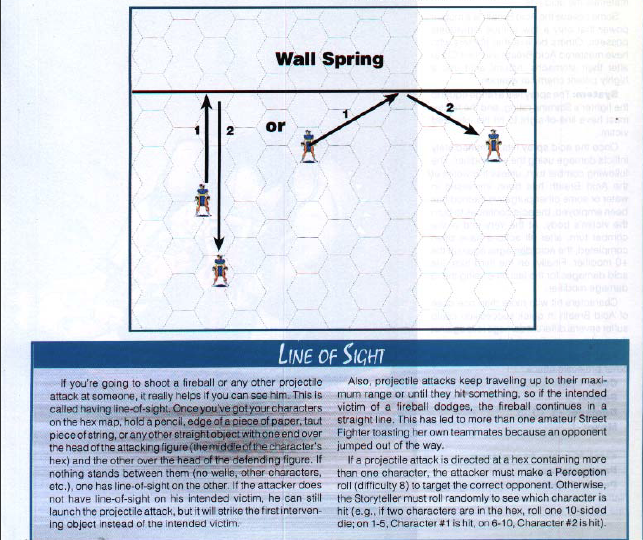
Wall Spring is not worth describing, but it demonstrates all the ways Chun Li can assume her Buffalo Stance. Also, how to burn people with your mind.
Next time, on Street Fighter
: I explain the combo system.
Chapter 7, Part 2: C-c-c-combo maker!
Original SA post
Street Fighter, Chapter 7, Part 2: C-c-c-combo maker!
Once you get some experience under your belt, Combo Maneuvers are an important part of making a good character. Simply put, buying combos gives you bonuses to playing chosen moves in sequence.
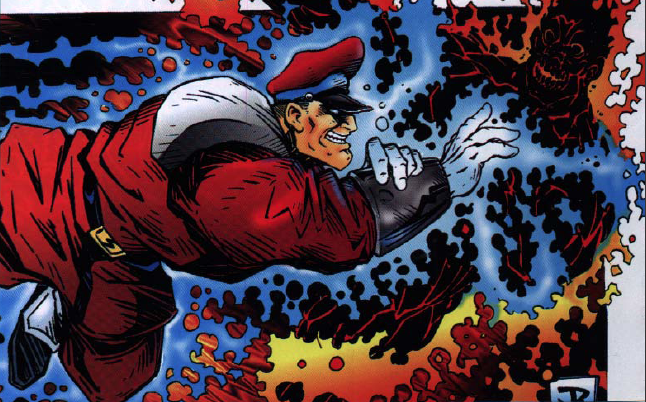
Bison uses his favourite combo, Crush Your Enemies to See Them Driven Before You to Hear the Lamentations of the Women (Dizzy)
Buying combos doesn't require you to write some new Maneuver that functions as a hybrid. Instead, it costs 1 Power Point to link a 1st maneuver with a 2nd maneuver, and another point if you want to link a 3rd maneuver. (Three is the maximum.) You can spend another Power Point to make it a Dizzy combo, meaning that the damage from all the maneuvers combines to determine whether or not it inflicts the Dizzy condition on your opponent. (That's really good, and can get abusive--more on that next chapter.)
You have to define the sequence of Maneuvers in the combat and play them in that order--if you buy Fierce Punch to Sonic Boom to Suplex , you can't switch it up and get the benefits for using Sonic Boom, then Suplex, then Fierce Punch.
What are the benefits of Combos? The second and third Maneuvers of a combo get +2 Speed. This allows you to use fast maneuvers to set up slow maneuvers that inflict lots of damage, Knockdown, or other good effects.
Other little bits at the end of this chapter:
Innovation
The book doesn't offer detailed guidelines for creating Special Maneuvers, but suggests that it is one of the best ways to make Maneuvers part of the story. The Storyteller gets final approval, of course, to prevent brokenly good Maneuvers. Unique Special Maneuvers are a great thing to give to recurring villains, and can also serve as quest rewards--"The winner of the tournament will be taught a secret style of Kung Fu" can be a much more powerful motivator than a ton of cash.
Adding Drama
Wow, finally a White Wolf game that comes right out and admits it! But no, this is just a brief section advising you to actuall describe your Maneuvers instead of just saying "I play Dragon Punch this round." It also encourages players to use their Maneuvers outside of combat.
Activation Word Bonus
A suggested houserule: Offer players an extra point of Glory when they win the match, if they announce their Maneuvers by naming them or with catchphrases like "Shoryuken!" or "Boot to the head!"
Chapter 8: Combat
Original SA post
Street Fighter the Storytelling Game, Chapter 8: Combat
The book waits until Chapter 8 to actually give you the fundamental rules for how the Traits, Maneuvers, and their statistics are actually used to run a combat. Because a) White Wolf and b) Fuck you.
Obviously combat is going to be a big part of a Street Fighter game, and the book doesn't beat around the bush on that. If you're not fighting in a tournament, you're probably playing spies and vigilantes and beating up people with even fewer rules.
First, let's get the format for tournament fights out of the way: A one-on-one fight usually starts the fighters 3 hexes apart, and lasts for 10 rounds. If no one is knocked out at the end of the round, the fighter with the greatest fraction of his total Health left is the winner. (Yes, it asks you to calculate that, not that it's hard. If I start with 14 Health and you have 10, and at the end of the round I have 5 Health and you have 4, you win because you have 40% of your total Health.) Team vs. Team fights often last until one team has had all its members eliminated.
Combat Cards
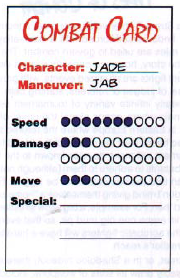
Street Fighter asks you to print out Combat Cards using the handy sheet in the back of the book, cut them up, and make a deck of your character's Maneuvers with the Speed, Damage, Move, and other stats printed on each one. It isn't hard. The game doesn't force you to draw a limited hand of your total Maneuvers--the point of having Combat Cards is that, like rock-paper-scissors, everybody lays down their chosen Maneuver at once. The turn sequence starts with the lowest Speed, and faster characters can interrupt slower characters to take their action first.
Speed : Dexterity + Maneuver Modifier. Speed determines the initiative of your Maneuver.
Damage : Strength + Technique + Maneuver Modifier. Determines how many damage dice you roll when the move connects. If you hit, subtract your opponent's Soak (Stamina, plus Block if they're blocking) and roll what's left against Difficulty 6 to inflict Health loss. Even if you roll no successes, or their Stamina+Block reduces your Damage to zero, any Maneuver that hits takes away 1 Health point.
Move : Athletics + Maneuver Modifier. Determines how many hexes you can move while performing the Maneuver. You must finish your movement before you make the actual attack, so no hitting and running unless a Special Maneuver (like Backflip Kick or Beast Roll) specifically allows it. As you saw last chapter, some Maneuvers specifically say you can only Move 1 hex, or can't move at all.
Basic Maneuvers
Everyone--Chun Li, Blanka, starting PCs, NPCs, mailmen and little old ladies--has access to 9 Basic Maneuvers.
Jab Punch: +2 Speed, -1 Damage, +0 Move .
Strong Punch: +0 Speed, +1 Damage, +0 Move .
Fierce Punch: -1 Speed, +3 Damage, -1 Move .
Short Kick: +1 Speed, +0 Damage, -1 Move .
Forward Kick: +0 Speed, +2 Damage, +1 Move .
Roundhouse Kick: -2 Speed, +4 Damage, +1 Move .
Block: +4 Speed, No Damage, No Move . Blocking is good for 4 reasons. One, it lets you add your Block Technique to your Soak total against every attack against you this round. Two, it's a special type of maneuver called an Abort Maneuver--for the cost of 1 Willpower, you can cancel any other Maneuver and replace it with a Block, so unless your opponent beats you by +5 Speed, you can save your ass. Three, on the turn after a Block, you get +2 Speed. (Yes, this means you can Combo a Block for +4 Speed after the Block.) Four, a Block prevents Knockdown from Maneuvers that normally cause it--unless the Maneuver also ignores Blocks.
Movement: +3 Speed, No Damage, +3 Move . When you just want to move across the arena.
Grab: +0 Speed, +0 Damage, 1 Move . Considering that Bear Hug, Throw, and "grab and smack" are all Special Maneuvers, I don't know what a Generic Grab is supposed to look like.
Grabs : Grabs require you to move into your opponent's hex to take effect, and most Grab maneuvers only have Move 1, so it's easy to be negated by a Knockdown Maneuver or an opponent interrupting your Move, stepping out of range, and hitting you. However, Grabs ignore Blocks.
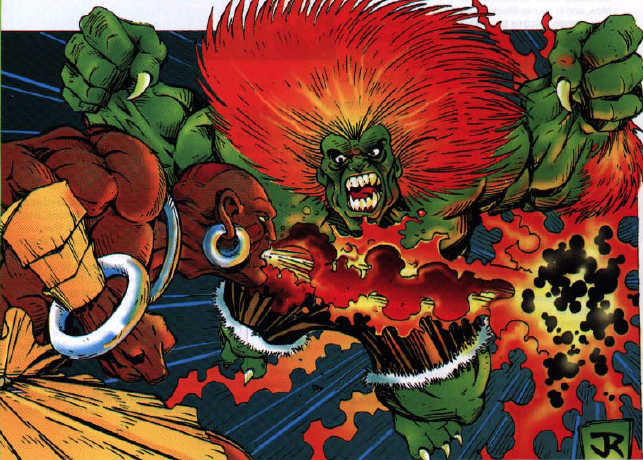
Dhalsim gets his revenge on Kirby Dots.
Order of Play
1. Choose your Combat Card in secret.
2. Everyone declares their Speed. Wits is the tie breaker.
3. Movement starts, beginning with the character with the lowest Speed. At any point during their movement, a faster fighter can declare "Interrupt!" and begin their own move--they can be interrupted in turn by a faster fighter. This does mean that you can be interrupted halfway through your move, by someone who has the same thing happen to them in turn, and all of you have to remember how much Move you have left.
4. Attacking. Here's where you lay down your Combat Card, reveal your chosen Maneuver, and deal damage and other special effects, assuming your opponent's still in range. Faster characters can't interrupt you after you declare you've finished Moving and lay down your Combat Card.
5. The character with the next-lowest Speed starts the process again.
Since you don't lay down your Card until you've declared Speed and finished Movement, the book doesn't tell you how to resolve it if somebody fucks up.
Status Conditions
Dizzied : If you take more damage from a single attack than your Stamina rating, you are Dizzied and lose your next turn. Dizzying an opponent is obviously amazingly great, but hitting a Dizzied opponent will cost you Honor points.
Unconscious : At 0 Health or less, you're unconscious until the Storyteller decides otherwise, usually until the end of the scene.
Death : There is explicitly and deliberately no rule for death in Street Fighter. Only the Storyteller can decide when someone dies.
Maneuver Advantages
Abort : As explained with Block, above, you can play an Abort Maneuver at any point during the turn by spending a Willpower point to change your declared Maneuver to an Abort. From the example given, this still works if you've already completed your Move--you can move in for a punch, get interrupted, and still Abort to a Block. (I'm pretty sure Block is the only Abort Maneuver in the corebook.) Abort also seems to be the only time you can interrupt someone after they lay down their Combat Card, since that doesn't happen until they finish moving and are ready to deal damage.
Aerial : An Aerial Maneuver takes place off the ground; if you're executing one, you can't be hit by Crouching Maneuvers or sweeps. ("Sweep" isn't a defined maneuver type, so it's up to the ST.) Again, the rules get confusing here--since you don't lay down your Combat Card until it's time to finish Movement and deal damage, does that mean I'm not benefiting from an Aerial Maneuver's protection until I've successfully played it? That doesn't jive with Maneuvers like Rolling Attack, where it's clearly implied that you spend all your Move flying through the air.
Crouching : Crouching is the opposite of Aerial; you're low to the ground, so you can't be hit by Aerial Maneuvers.
Knockdown : When you inflict Knockdown on an opponent, it does one of two things: If they're already acted this turn, their Maneuver next turn is at -2 Speed. If they haven't acted yet, they forfeit their action!
Multiple Hit : Some Maneuvers allow multiple damage rolls. They mention that here to remind you that the damage doesn't combine to inflict Dizziness, unless the Maneuver's part of a Dizzy Combo.
Sustained Hold : If you land a Grab attack that's a Sustained Hold, you automatically inflict damage each successive turn until you release it or the opponent escapes. At the end of each Combat Turn, the opponent tries to win a Strength vs. Strength contest--otherwise, they forfeit their action next turn, and the holder can just play the same Combat Card and inflict Damage when their Speed comes around. You can maintain a Sustained Hold for a number of turns equal to your Grab before you have to let go. Obviously, these can be absolutely crushing when Wrestleman grabs ahold of Wuxiagirl.
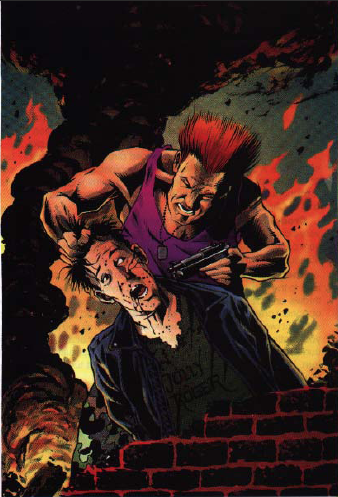
Two-tone spiked hair, purple tank top, camo pants. This is what dangerous gangbangers look like in 80s karate movies.
Weapons
Honorable Street Fighters never use weapons--the proper way to beat someone up from a distance is to set him on fucking fire with your mind, not use a Taser. Still, Duelist characters use weapons, as do cops, thugs, and of course, ninjas.
Melee weapons are pretty simple--if you have one, they provide bonuses to Speed, Damage, and Move. (Holding a quarterstaff makes you run faster!) You have to buy an individual Weapon technique to use them, though, which makes them a bad investment for PCs unless you're actually playing a Duelist. The ST is advised to use their own best judgment when determining if a Special Maneuver can be used with a weapon, and to invent Special Maneuvers designed to be used with weapons if need be. The examples given are Quarterstaff, Nunchaku, Broadsword, Rapier, Katana, Spear, and Knife.
Firearms are a different story. The book notes that they're deliberately making guns simpler and less lethal than they actually are, and gives stats for a Pistol, Rifle, Scattergun, Blaster Pistol, and Blaster Rifle--I guess the designers were watching the Street Fighter cartoons where the bad guys got laser guns. A Pistol is +2 Speed, +3 Damage, while a Rifle is +0 Speed, +5 damage, so a pack of Shadoloo thugs with handguns can still really ruin your day. There are also rules for heavy weapons--a hand grenade, rocket launcher, and time bomb, believe it or not.
Strangely, the book also provides three suggestions for secret agent gadgets--the examples given are a sleeping-gas capsule, sharpened throwing hat (nice way to sneak rules for Kung Lao in there) and a wrist computer that acts ilke a repository of free Knowledge skills. Clearly, they want you do be doing the cop/vigilante/secret agent type campaign when you're not busting faces.
Finally, the book recommends having a "Stunt Card" in your deck of Combat Cards--that's what you lay down if you decide you want to do something crazy like swing on a chandelier or try to knock down three thugs at once by throwing a banquet table at them. Call it the Jackie Card.
Chapter 9: Storytelling, Such As It Is
Original SA post
Street Fighter the Storytelling Game, Chapter 9: Storytelling, Such As It Is
I've been holding off on this, since there's just not much fun mechanical crunch to chew through in the "how to actually roleplay" chapter.
You can tell that this game was written with roleplaying newbies in mind, and that's not a bad thing. The "Storytelling" chapter reiterates that Street Fighter is exactly that kind of game, and talks up the benefits of being willing to take on the extra reading and prep time required of the Storyteller. It also implores you to use the sample adventure as your first adventure, with reminders of really basic stuff like "up the difficulty if the PCs are World Warriors, and keep PCs at the same power level."
The chapter gives the Storyteller an elementary list of things to keep in mind. The first responsibility is to keep everyone entertained. Give the players the right amount of challenge. Bend, break, and create new rules as needed to have a good time, and remember that the rules can't cover everything. Make the experience real for the players by describing sights, sounds, and smells.
Chronicle Concepts
This is where the book really reveals the types of stories it intends you to tell with the game: basically the plots of 70s and 80s martial arts movies.
The number one option, of course, is "Against Shadoloo." Characters can be motivated to stop Shadoloo out of a one-dimensional desire to see justice done, for revenge on some Shadoloo agents who've done them wrong, or as trained government agents (or coopted Street Fighters) sent to investigate and infiltrate the organization. The book goes out of its way to suggest a kung-fu-movie version of Interpol like the one implied in Enter the Dragon , conducting international investigations into Shadoloo's criminal activities. (For those who don't know, Interpol doesn't conduct investigations. They're more like an information clearinghouse of data that they share with law enforcement organizations.) Running an anti-Shadoloo campaign is pretty easy, the book suggests, because when the PCs don't know how to find Shadoloo, Shadoloo will find them, attempting to recruit them, intimidate them, or silence them for good.
"Personal Attainment" is another suggested option, although it receives about a quarter as much attention as fighting Shadoloo. These chronicles will rely on the PCs personal motivations to drive the story, which is, of course, a lot harder with new players.
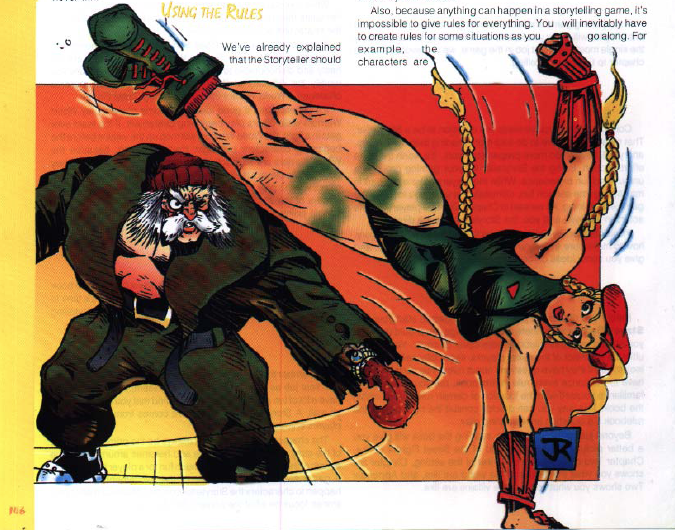
I fucking love all the pictures where the characters look surprised because they can't figure out their spacial relations to one another.
Story Concepts
The book is a little more thorough when it comes to suggesting ideas for stories lasting one or several sessions. First up is Revenge , which forms the basis for at least half of all martial arts movies. To its credit, the book actually suggests revenge-based plots that force a wronged PC to rely on his mates for help--a criminal organization ruining his fortune or holding his family hostage, a much more powerful Street Fighter wrongfully attacking the PC or their friends, or a powerful enemy decides to make the team's life miserable because of a perceived personal slight.
Espionage goes a long way to explaining the other kind of campaign the game implicitly suggests you run: secret agents. This can be anything from stealthy in-and-out heists against Shadoloo or some other evil organization, or actually trying to take down a criminal cartel from within. Next is Rescue , which has the advantage of being a good way for PCs to build Honor and Glory and also allowing the ST to shift the scenery to exotic locales. The book suggests that PCs can be going about their business as Street Fighters when they receive news of bad things happening to good people, and feeling compelled to intervene. Their loved ones can be held for ransom, and lastly, "retrieve the valuable MacGuffin stolen by the Nazis/Shadoloo" can be considered a rescue story.
Disaster stories differ from Rescue stories in that the peril is mainly imposed from without--the PCs are stuck in the middle of a natural disaster, a boat with a bomb about to go off, and so on, and traps and hazards come out of nowhere to force the pace.
Mystery stories. Welp,
Rollins scratched his head and sighed. Thirty years on the force and they bump me aside for this, a girl not even out of her teens. what could she discover that he hadn't already? He shook his head and spoke up. "well, Miss? Found anything?"
"Yes, many things. Lots of good clues," she said, not even looking at him as she combed the study, searching for leads to the murder."
"Oh? Care to share them with me?" Rollins said.
Chun Li turned toward him, looking embarrassed. "Oh, I'm sorry, detective. I sometimes get so involved that I forget my manners. Forgive me."
"Uh, sure. Just tell me the clues," Rollins said.
Tell him the clues, Chun Li.
Exploration stories are another opportunity to throw the PCs into exotic locales. Lost cities, ancient artifacts, Johnny Quest with Flash Kicks.
Finishing Touches
The chapter advises beginning Storytellers to write an outline, then design adventures by setting a plot concept, choosing a setting, deciding on an atmosphere, and then breaking the story up into expected scenes. It's not bad advice.
Next time, on Street Fighter : High Stakes, the introductory adventure.
Appendix 1: High Stakes
Original SA post
Street Fighter, Appendix 1: High Stakes
Like plenty of other games, Street Fighter includes an introductory adventure. As I recall, it's pretty good; it sets up a scenario built around the PC team's first fight, while adding in a bit of crime-fighting intrigue that's a touch more thoughtful than "Attacked by thugs, beat up thugs." It starts by giving you a scene breakdown:
Scene 1: Balrog is hosting a tournament at a Las Vegas casino and has invited fighters of all ranks and classes to attend. He's asked for another World Warrior to fight him as the tournament's marquee event, and Guile's accepted. Shadoloo involvement is widely suspected. The team arrives in Las Vegas and gets to see the sights before things heat up.
Scene 2: In the casino, the team sees a pack of thugs chasing a shrimpy-looking guy. If they help him out, he'll tell them about an embezzlement scheme set up by Balrog's manager, Mr. Ray. If they don't, well, uh, half the adventure goes down the drain.
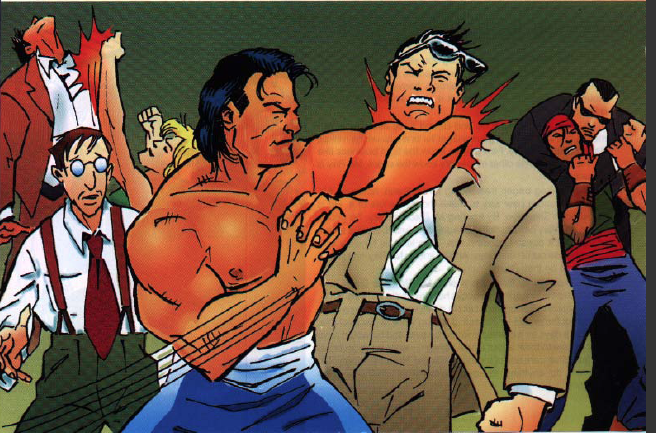
Free Woody!
Scene 3: Assuming they help The Weasel (the shrimpy guy), the team has to bust into Mr. Ray's office to gather evidence. They might get caught by Samson Jr., a young fighter who admires Balrog.
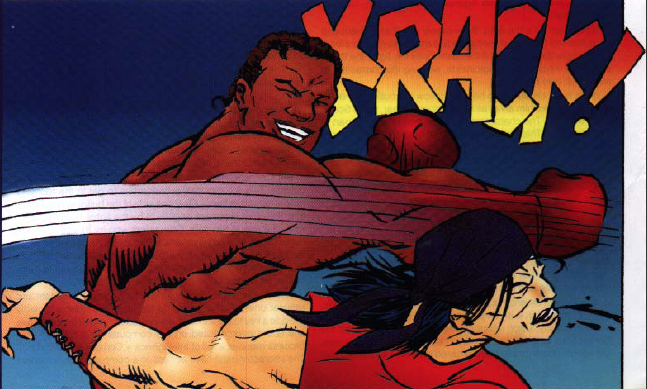
You are ordered to leave the Bronx.
Scene 4: Tournament time! If the team gathered the evidence, the jig is up, and they'll earn some favours at the expense of pissing off Balrog. Either way, they get to have their fights.
Scene 5: Wrap-up, and finding out the consequences of their actions.
Because this is a White Wolf game, the adventure includes notes on atmosphere, and recommends a blend of "kung fu fighters vs. the mob" crossed with more action-heavy gangster movies like The Untouchables . It also advises the ST to wring as much as possible out of the atmosphere of Vegas--glitz and glamour over top of a seedy underworld, bizarre attractions, and the many potential opportunities and risks the PCs can have with people who want a piece of the action of an up-and-coming Street Fighter, who may or may not be trustworthy. Surprisingly, it also includes mundane notes about how much a taxi costs.
Although the book has said before that only Traditional tournaments are legal, this all-invite tournament is apparently legal too, as it's held in a casino and is attracting singers, dancing girls, and all the other hullabaloo that goes with a Vegas show. Whenever someone wins a fight, people throw money into the ring.
Balrog : Balrog is a fierce fighter; he used to be a championship heavyweight boxer, but lost his title after "a controversial knockout." He's only gotten better since he became a Street Fighter. Balrog is a genuine rags-to-riches story and is widely idolized despite his shady past, but most people don't know that he's working for Shadoloo. His motivation, quite simply, is money and fame.
Mr. Ray : Ray has been Balrog's manager for years, and he's legitimately very, very good at his job. He's been making extra money for Balrog and himself by investing in Shadoloo and laundering their money for them. Balrog doesn't have a problem with that, but he'd have a very big problem if he knew that Ray has started skimming off the top of Balrog's earnings.
Scene 1 : The team's manager, assuming they have one, tells them they already have flights and hotels booked to Las Vegas--the upcoming tournament is their big chance to make a splash. They arrive the day before the tournament at a cheap hotel, and don't have any options except to get out on the Strip and unwind a bit. They can go anywhere they want, and are free to gamble--the adventure gives quick tips on stuff like rolling Wits+Insight to see if they win. This is also a good opportunity for them to run into other fighters attending the tournament--they should avoid starting any fights--or to run into Guile and either piss him off or curry favour with him.
Scene 2 : At some point the team will have to converge on Balrog's casino. They can watch the stage being set up or gamble in the casino, but at some point a "weasely guy" trips and falls next to their table while fleeing from some bouncers. He claims they're trying to kill him and begs for help. If they agree, the thugs won't start the fight in the casino, but wait until they escort The Weasel (yes that's his name) outside before they start shit. If they win, the Weasel asks for further help. If they lose (not likely, as these guys have mook stats) the thugs drag the Weasel back inside. If they choose not to help, they just missed half the adventure.
Even if they don't want to help, or get beaten, the ST is advised to reintroduce the Weasel later--say, maybe the team sees him being brutally beaten in an alleyway.
The Weasel : His real name is Arthur Parkington. When the team gets him to safety, he explains he's an accountant who worked for Mr. Ray. He's done some shady stuff before, but Shadoloo is out of his league. When he called the FBI to make a deal, his phone was bugged, and the thugs came after him immediately. He wants the team to break into Ray's office in the Palace hotel and steal some files that would seal the deal on putting Ray in jail and granting the Weasel immunity. If the team refuses to help, he'll try it himself and fail, and the team will miss part of the adventure and fail to learn anything about Shadoloo.
Scene 3 : The break-in. The team can try to beat up the thugs guarding the office and take their keys, or steal one from the hotel staff. They can also try climbing the walls of the hotel, or even hack into the hotel computer to register themselves as guests of Mr. Ray and get keys.
If the team runs into Balrog's protege, Samson Jr., he'll challenge one PC and sending the thugs to deal with the others. If they've already gotten the files, he'll make a point of letting them go if his challenger beats him.
Once the PCs get the files from the office that the Weasel asked for, they just have to get them back to the Weasel. They might also have found a file marked "Kraken." The Weasel thanks the team and goes straight to the cops--who may actually be cops, or may be the Las Vegas mob offering the Weasel protection in exchange for dirt on Shadoloo, as an optional plot twist.
Scene 4 : The casino is already crowded by the time Balrog's limo pulls up. Assuming they completed the mission for the Weasel, Balrog scowls at them before putting on his face for the crowd. After he gives an "Only in America" speech, the tournament begins. The adventure suggests the PCs have individual fights or a team fight, and that when it's time for Guile to fight Balrog, the team can control Guile while the ST plays Balrog. It also suggests some key moments for the PCs to interact with fans--fans wanting to tear off bits of their fighting clothes for souvenirs, someone trying to start side bets with them, an opponent's fans trying to pick a fight, or opportunists trying to talk the PCs into quick ringside deals as far as sponsorships and such are concerned.
Scene 5 : The characters get their just desserts in money, Honor and Glory, depending on whether they won or lost. They also earn Glory and Honor if they completed the Weasel's mission. They've also earned the enmity of Mr. Ray and Balrog, who doesn't like anyone messing with his business even if they uncovered a traitor in it. If they found the "Kraken" file, it contains information on Shadoloo's really ugly operations around the world--mercenaries and warlords funded by Shadoloo.
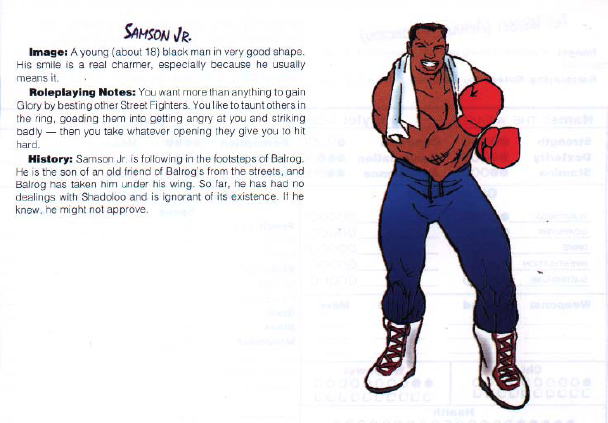
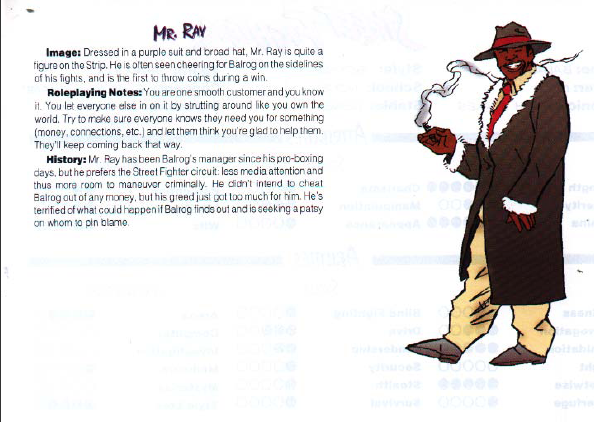
The book actually features Balrog as another World Warrior and Boxing as another style, but squirreled it away in this chapter.
Boxing : Everyone knows what boxing is. It's been around since ancient times, and became a big-money sport in the 20th century. Most boxers on the Street Fighter circuit still wear boxing gloves and don't vary their arsenal much, despite the change in rules.
As a style, I guess boxing's not so bad if you just want to punch people. As you'll see in the Player's Guide (at some point), boxing suffers from the same bad design that the writers would go on to apply to any "real-world" style that got translated into Street Fighter--not embellishing it for the sake of a world where people think fireballs at each other. Like, why couldn't a boxer learn the Dragon Punch?
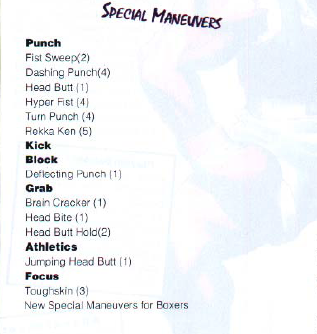
Balrog : Balrog was a poor kid who had the sense to realize that his only way out of his poor Harlem neighborhood was fighting, so fight he did. He trained nonstop and wiped the floor with all his challengers, until he seized the world heavyweight championship with the most stunning right hook in the history of boxing. At first, being champion didn't change him, but then he caved to a manager who promised him more money and fame. His new backers encouraged him to party more, train less, and forget about the people who helped make him famous in the first place, all of which led to a fight with a dark horse challenger than Balrog just couldn't handle. His backers, unbeknownst to him, smeared a tranquilizer on his gloves. After one punch, his opponent fainted--and so did the referee who raised Balrog's glove. The scandal ended his boxing career for good. That's when M. Bison stepped in, offering Balrog a new career in Street Fighting and a chance to make money as Bison's head enforcer in Las Vegas.
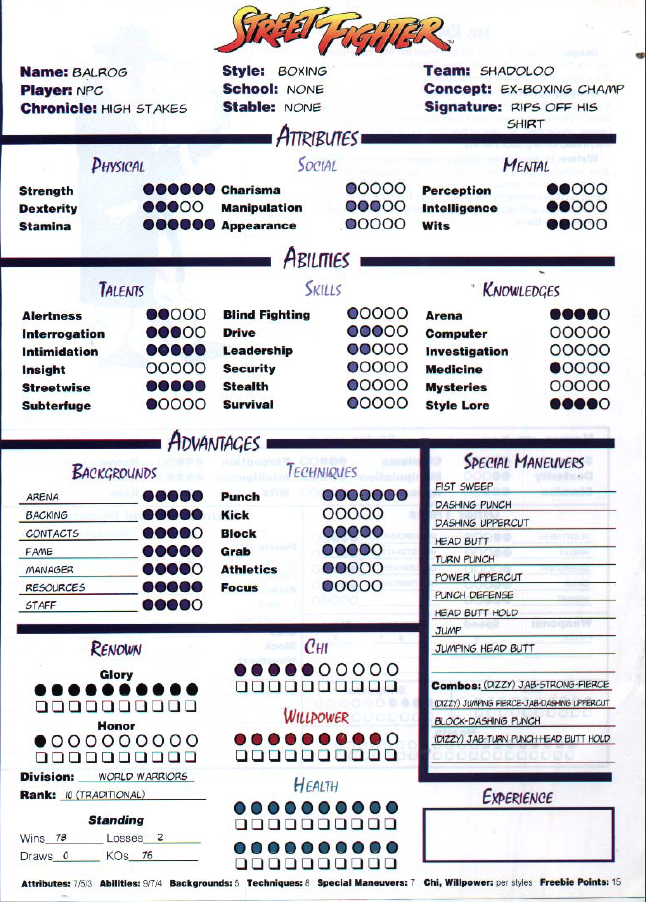
Idiot punch man
Next time, on Street Fighter : Paper dolls.
Appendix 2: Free Stuff
Original SA post
Street Fighter, Appendix 2: Free Stuff
The last few pages of Street Fighter are devoted to stats for standard antagonists--thugs, gangsters, cops, mercenaries, and of course, ninjas, as well as a sample team of Street Fighters, Team Raven, who can be used as antagonists in the High Stakes tournament. I'm not going to write that up because I don't care about that. But look at this shit they give you after the index!
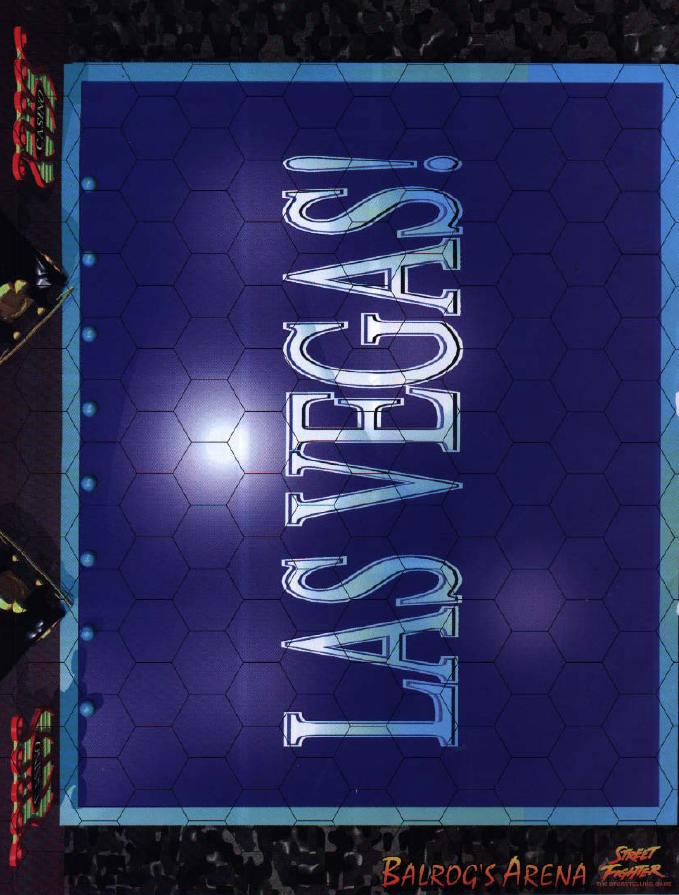
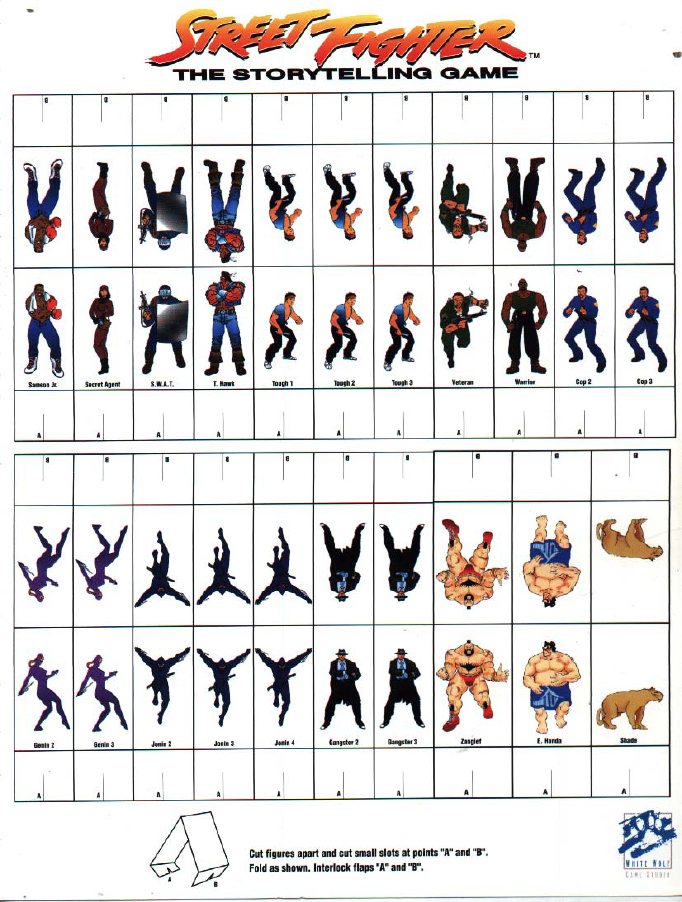
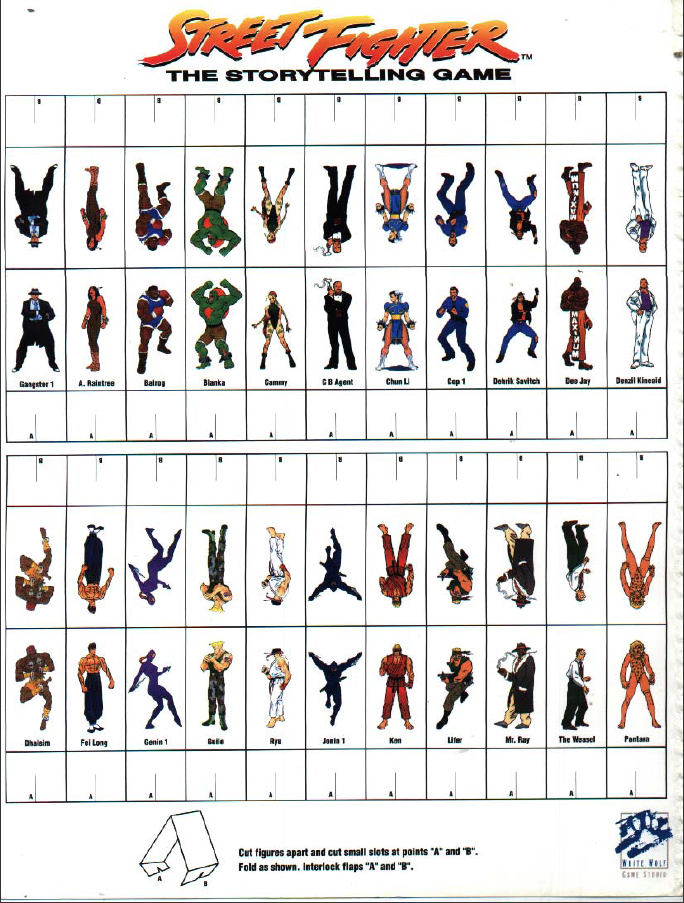
Fuck yeah.
As a final note before we finish the book, I wanted to address a recurring issue from both these updates and the WTF?D&D articles: the ridiculous art. I think the root of it, really, was 90s Xtreeeme comics. Street Fighter was released in 1994. 1992 and 1993 saw the birth of Image, Malibu, and Milestone Comics, with titles like Youngblood, Hardcase, Warstrike, Deathblow, Cyberforce, Codename:Firearm, Freex, and Blood Syndicate. It was a time when superheroes were increasingly grim, ultraviolent antiheroes who took themselves way too seriously and looked like this:
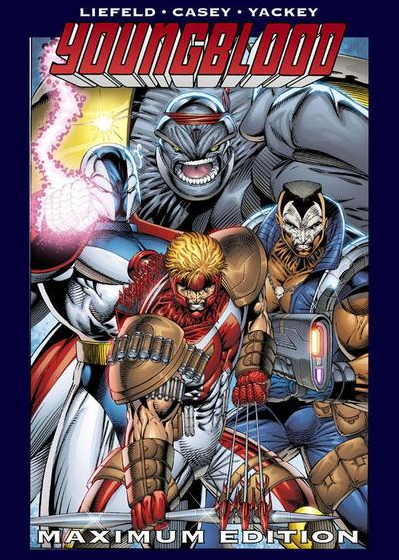
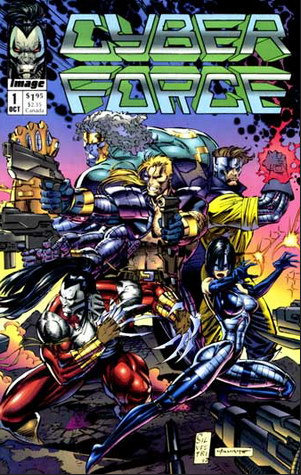
So, yeah. Guile and Chun Li are trapped in a world full of cyborg mutant pro wrestlers because of Rob Liefeld.
That's it for the Street Fighter corebook! I want to do the supplements, but honestly, after seeing others do SLA, Fading Suns, and Kult, I'm dying to do a hilariously 90s game first. How about Immortal: the Invisible War ?